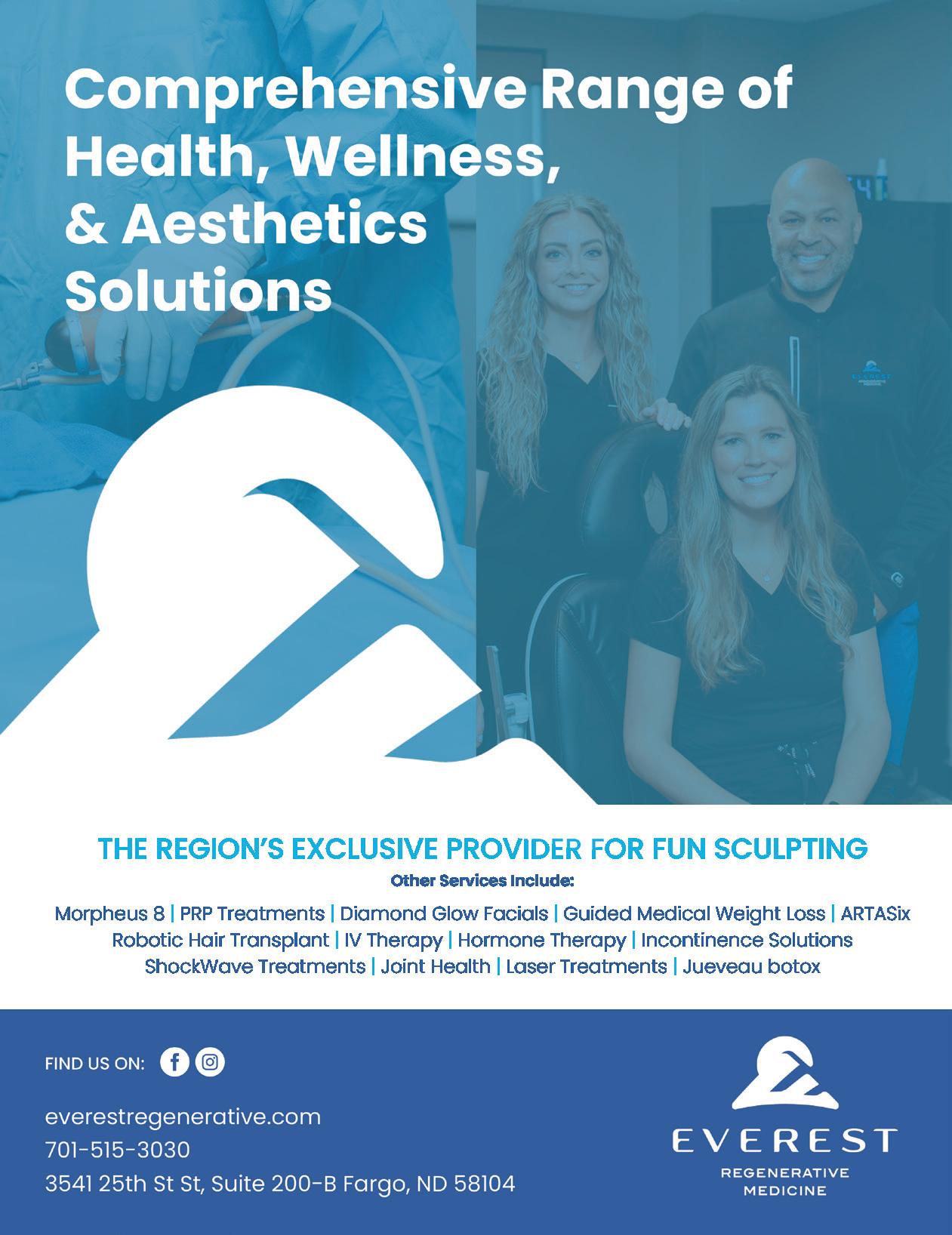
We talked to experts about what to do about fire damage, financial disaster, sexual harassment, and more!










Partner
Partner
Dealing
Drinking
Surviving














We talked to experts about what to do about fire damage, financial disaster, sexual harassment, and more!










Partner
Partner
Dealing
Drinking
Surviving


















fargoinc@spotlightmediafargo.com




























Mike Dragosavich
Geneva Nodland
Cowles Ty Betts Josiah Kopp
Gravseth (Ladyboss Lifestyle)

Sam Winter Sam@SpotlightMediaFargo.com
Al Anderson Al@SpotlightMediaFargo.com
Tori Konrady Tori@SpotlightMediaFargo.com
Dave McSparron
Dave@SpotlightMediaFargo.com
Austin Cuka
AustinCuka@SpotlightMediaFargo.com
Ellen Hannaher-Brenchley
ClientRelations@SpotlightMediaFargo.com
Jenny Johnson
Jessica Ventzke
Missy Roberts
John Stuber




Fargo Monthly is an award-winning publication dedicated to highlighting Fargo-Moorhead and what makes it a truly enjoyable place to live.
fargomonthly.com facebook.com/fargomonthly X: @fargomonthly Instagram: fargomonthly

Future Farmer is our farming publication which brings great tech-focused content to readers across North Dakota and Minnesota.
futurefarmermag.com facebook.com/FutureFarmerMag


Home by Trendsetters Magazine is dedicated to covering all of the beautiful homes, home trends, and amazing professionals driving the industry forward.
@homebytrendsetters /HOMEbyTrendsetters


Bison Illustrated is your number one source for all of the behind-the-scenes action inside the North Dakota State University Athletic Department.
bisonillustrated.com facebook.com/bisonillustrated X: @bisonmag Instagram: bisonillustrated


You may already be familiar with our Faces of Fargo-Moorhead-West Fargo publication which we publish once per year in order to highlight the faces behind all of the great businesses in the community.
Are you in need of a new career? The Great Places to Work Fargo-MoorheadWest Fargo Annual Career Guide highlights amazing businesses in the area that provide great growth opportunities, benefits, and more!



By NorthStar Technology Group

magine this: you’re starting your day with a fresh cup of coffee, all ready to tackle your to-do list, when an email that looks to be from a trusted partner lands in your inbox. It seems legitimate, but hidden inside is a phishing trap set by cybercriminals.
This scenario is becoming all too common for businesses—both big and small.
Phishing scams are evolving and becoming more sophisticated every single day. As a decision-maker, it’s essential that you understand these threats and can debunk common myths to effectively protect your business.
Many people believe phishing scams are easy to identify. They think they can spot them due to poor grammar, suspicious links, or blatant requests for personal information.
However, this is far from the truth. Modern phishing attacks have become highly complicated, which makes them more difficult to detect. Cybercriminals now use advanced techniques like AI to create emails, websites, and messages that closely mimic legitimate communications from trusted sources.
Most phishing attempts today look authentic; they use logos, branding, and language that resemble those of reputable companies or persons. This level of deception means that even well-trained individuals can fall victim to cleverly disguised phishing attempts.
Phishing scams come in various forms, and each form exploits different vulnerabilities. Understanding the most common types can help you better protect your business:
This is the most common type. Cybercriminals send emails that appear to be from legitimate sources, such as banks or
well-known companies. These emails often contain links to fake websites, which they use to steal sensitive information.
This method targets specific individuals or organizations. Attackers gather information about their targets to create personalized and convincing messages, making it particularly dangerous since it can bypass traditional security measures.
This is a type of spear phishing that targets high-profile individuals like CEOs and executives. The goal is to trick these individuals into revealing sensitive information or authorizing financial transactions.
This type is a social engineering attack that involves sending phishing messages via SMS or text. These messages usually contain links to malicious websites or ask recipients to call a phone number, prompting them to provide personal information.
This method involves phone calls from attackers posing as legitimate entities, such as banks or tech support, asking for sensitive information over the phone.
In this type of phishing, attackers

duplicate a legitimate email you’ve previously received and replace links or attachments with malicious ones. This tactic exploits trust, making it hard to differentiate a fake email from genuine communication.
Here, cybercriminals use QR codes to direct victims to malicious websites. These codes often appear on flyers, posters, or email attachments. When scanned, the QR codes take you to a phishing site.
To safeguard your business from phishing scams, follow these practical steps:
• Train employees regularly to recognize the latest phishing attempts and conduct simulated exercises.
• Implement advanced email filtering solutions to detect and block phishing emails.
• Use multi-factor authentication (MFA) on all accounts to add an extra layer of security.
• Keep software and systems up to date with the latest security patches.
• Utilize firewalls, antivirus software, and intrusion detection systems to protect against unauthorized access.
By now, it’s clear that phishing scams are constantly evolving, and staying ahead of these threats requires continuous effort and vigilance.
If you want to learn more about protecting your business from phishing and other cyber threats, get in touch with NorthStar Technology Group.
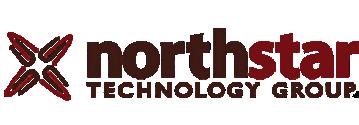

he Inflation Reduction Act of 2022 was signed into law in August of that year. It includes a section that modifies the Medicare Part D plan by expanding benefits and lowering drug costs with an aim to improve the sustainability of Medicare. These are among the most significant changes to the Part D program ever enacted.
Starting in 2025, the law requires all Medicare prescription drug plans (Part D), including stand-alone plans and Medicare Advantage plans with prescription drug coverage, to offer Part D enrollees an option to pay out-of-pocket prescription drug costs in monthly installments rather than all at once at the time of purchase.
It’s called the Medicare Prescription Payment Plan, and it is intended to especially help people with high cost-sharing earlier in the plan year by spreading expenses over the entire plan year. It’s available to everyone with Part D coverage but may not benefit every enrollee. That’s why it’s recommended that benefits managers work closely with their insurance broker to make sure they’re appropriately maximizing the benefits from the new law.


The payment plan (also referred to as “copay smoothing” or “M3P”) may not be the most effective option for members unless their average monthly Part D costs are greater than $167. (That said, the plan is still an option for all Part D members).







BY JOSIAH KOPP & TRACY NICHOLSON | JOSIAH KOPP
or over 35 years, JLG Architects has been a cornerstone in helping (quite literally) shape North Dakota's communities. From the Theodore Roosevelt Presidential Library to various educational centers, JLG's portfolio is nothing short of impressive—now, they're adding another groundbreaking project to the Fargo community: the Fargo Parks Sports Center.



The Center, which opened in June of 2024, marks the completion of the first phase, totaling approximately 290,000 square feet. When phase II is completed in early 2025, the facility will boast nearly 400,000 total square feet, offering a multi-purpose community recreation facility that accommodates indoor sports, activities, tournaments, and special events.
Fargo Park District's vision for the Center was to have a facility that offered year-round wellness, centralized with a sense of community. Along with McGough Construction, JLG brought this vision to life, creating indoor space for turf, courts, ice, Fargo Park District central offices, building administration, walking track, Sanford Power Center, and multipurpose community space—all located along a central concourse for exposure to natural daylight and high visibility into a variety of athletic spaces.
Full Size Indoor Multi-Use
Turf Field + Elevated Indoor Track
Hardwood Courts
Sheet Ice Facility
Pickleball Courts
Large Community Rooms
Small Community Rooms
Indoor Playground and Party Rooms
Concession Areas
Sanford Sports Performance Fargo Park District Offices

SENIOR DIRECTOR OF PLANNING AND CONSTRUCTION, SANFORD HEALTH
"The Fargo Parks Sports Center focuses on bringing our entire community together to share experiences while focusing on health, wellness, and human connection. It also will be a beacon for youth sports and events that will attract people from all over the region to visit the Fargo Metro.
I am most excited about all the opportunities and activities that this facility will allow the members of our community, especially the youth, to enjoy, in an inclusive space where all are welcome!"
CONTINUED >

EXECUTIVE DIRECTOR, FARGO PARK DISTRICT FOUNDATION
"This facility directly addresses a critical need we identified in our needs assessment study in our community and region for more indoor recreation space. That study clearly showed the growing need for amenities including an indoor walking track, soccer field, hardwood courts, ice, and community rooms. With the help of our community partners, this state-of-the-art facility that will serve our region for generations to come. I am very excited to have a true community facility of this magnitude in Fargo that provides accessibility to sports, community events, arts programs and so much more. It's unique to have an indoor facility with turf, courts, and ice all under one roof. This truly is a national-level facility that our community will enjoy and provides opportunities for our youth, families, and seniors."

EXECUTIVE DIRECTOR, FARGO PARK DISTRICT
"The Fargo Parks Sports Center provides a space to bring community together. The sports center will serve more than 20,000 children, provide gathering space for more than 20 local community organizations, and attract more than one million local and regional visitors annually. I am most excited that the Fargo Park District, along with the community's support, was able to build a facility that will provide yearlong recreational activities for the community to enjoy."

PRINCIPAL ARCHITECT AND HEALTHCARE STUDIO LEADER, JLG ARCHITECTS

DIRECTOR OF PRECONSTRUCTION, MCGOUGH CONSTRUCTION
"The Fargo Parks Sports Center will build upon the incredible amenities Fargo has to offer for its residents. The Sports Center will enhance the recreational options for area residents and visitors, create new economic opportunities, and improve the quality-of-life offerings to prospective residents considering moving to the area. I am excited to see family and friends use the facility and make lifelong memories there."
"This building will act as not only a place to gather as a community but also attract visitors from all over the region to participate in tournaments and clinics and partake in all the Center has to offer. At JLG, we are committed to our communities, with the goal of using design to elevate our lived experience through buildings that serve people, engage and energize communities, welcome wellness, and conserve resources. To be able to help lead an effort that created a building and spaces that truly align with that goal has been a blessing. I am most excited about putting the community on par with any city in the country with the scale and quality of indoor athletic and wellness spaces, where not only the metro area gathers but a place to welcome visitors from around the region and country."

At its core, the Fargo Parks Sports Center is an example of the Fargo community coming together through a collaborative effort. Starting in 2018, McGough Construction worked closely with Fargo Parks, JLG, and Sanford to provide estimating and constructability expertise while the project was being designed. During construction, those same partners were an integral part of the project team along with over 40 local and regional trade partners. All of the project partners contributed to the successful (on time and under budget) completion of Phase I.
"The sports center is a true testament to the power of collaboration and shared efforts—the space will be a constant reminder that we can go farther

together," Susan Faus said. "The partnership with Sanford was crucial to bringing this vision to life."
"The facility we were able to deliver would not have been possible without the incredible generosity of our community and over 30 businesses and families partnering with our foundation," Craig Bjur said. To date, the project has secured over $45 million in value, with over $36 million in donations and $9 million in kind gifts and services. Sanford's partnership with Fargo Parks District, along with the creative power of JLG Architects, was very critical to the success of the Sports Center project.
The Fargo Parks Sports Center is located on 123 acres, west of I-29 and between 52nd Avenue South and 64th Avenue South Fargo. Stop in and experience the facility, including free access to the indoor track.
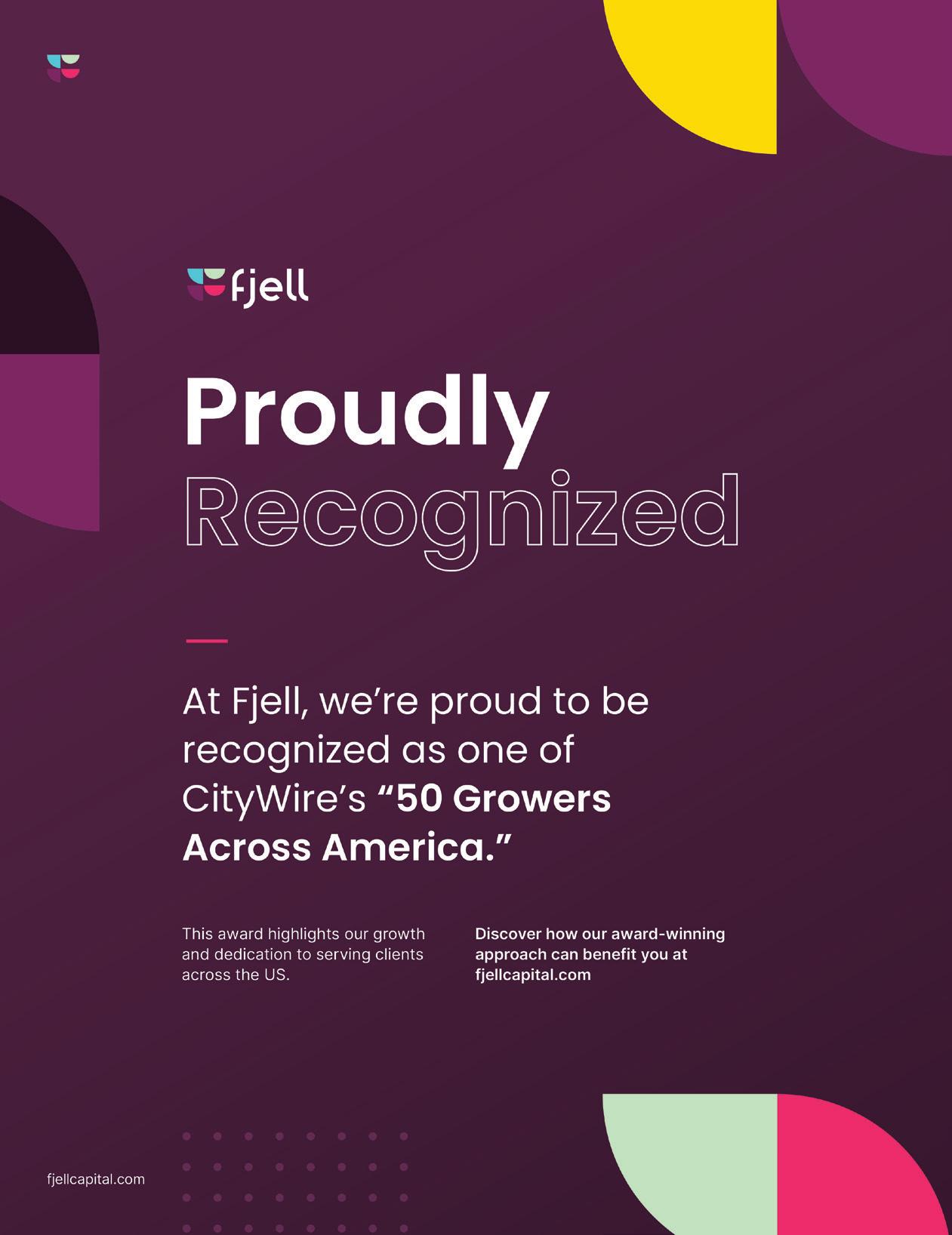


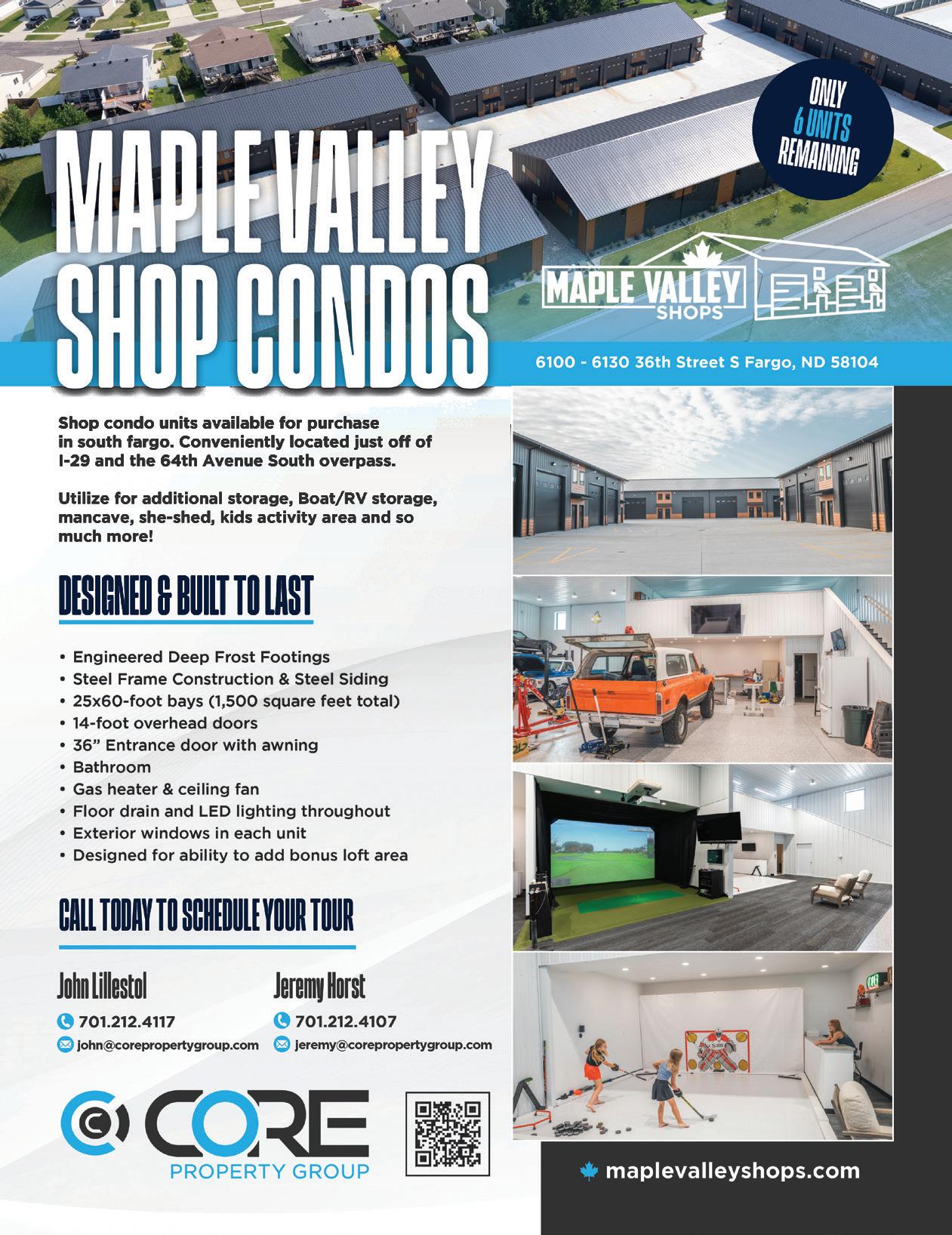

WE TALK TO EXPERTS ABOUT WHAT TO DO ABOUT FIRE DAMAGE, FINANCIAL DISASTER, SEXUAL HARASSMENT, AND MORE!

BY BRADY DRAKE


Challenges are inevitable and disasters are likely. Whether you're leading a small startup or managing a large corporation, unforeseen obstacles can arise at any moment. It's not unusual to have the resilience and adaptability of your organization tested. These disruptions, while daunting, also present opportunities to grow stronger and more prepared for the future. It’s not a question of if adversity will strike but when— and how you will respond. In this series, we explore the critical steps businesses must take to not only recover from setbacks but to emerge with a renewed sense of purpose and stability. From preparedness to implementing strategies that build resilience, we spoke with local experts to help you survive your next business disaster.




As the owner of the CPA firm Haga Kommer, Aspire Bank, and Aspire Insurance, Toby Kommer knows numbers. He has helped countless businesses scale, balance budgets, and overcome financial disasters.
Of course, you never want to face a financial disaster, but what if you do? We asked Toby that very question.

Q: WHAT ARE SOME TYPICAL FINANCIAL DISASTERS BUSINESSES FACE?
A: It almost always comes down to cash. Cash flow is the root of almost all financial disasters and cash flow issues can come from a few different areas. A company could lose a top client. Or, the most common thing I see is a top client running into financial issues. There have been many situations where a top client is a great payer for 20 years and then all of a sudden, they can't pay—that can put a cash flow crunch on a business.
Q: WHAT ARE SOME THINGS COMPANIES CAN DO TO AVOID THIS?
A: A lot of people, when it comes to personal finance, will have 2-4 months of expenses saved in the bank in case something happens. I think from a business perspective, it's wise to do the same thing. Obviously, each business is unique in terms of the overhead they have and all of the
other factors at play. But overall, it's a good practice.
Q: IF A BUSINESS DOES FIND THEMSELVES IN A FINANCIAL CRISIS, WHAT ARE THE FIRST STEPS THEY SHOULD TAKE TO ADDRESS IT?
A: In the technology realm, I think almost every business has a disaster recovery plan. They have a plan for what to do if they get hacked. They have a plan for if their technology is down for two days. They have a plan for if their server is damaged. Even companies that aren't in the technology space will have their data backed up or they'll have a second server.
I don't see enough businesses that plan for that and are prepared in that way for a financial disaster. One thing they could do is have a line of credit readily available from the bank. I think the first step should be accessing a line of credit.
Before that even, businesses should have plans in place for both shortterm and long-term issues and a healthy amount of cash reserves. Businesses should also have a plan for restructuring the company in place.
Q: HOW COMMON IS IT FOR BUSINESSES TO NOT HAVE A PLAN IN PLACE?
A: I would say it's extremely common. I would say it's almost uncommon to see somebody who's actually given some thought to a plan.
Q: AS A BUSINESS OWNER YOURSELF, HAVE YOU ALWAYS HAD PLANS IN PLACE? OR IS THAT SOMETHING YOU CAME TO LATER IN YOUR BUSINESS CAREER?
A: I think I'm a little bit of an anomaly being a finance guy and an accounting person who is very numbers driven. I've always lived off of what I call the financial Bible, and that is my annual budget, my cash flow projection, and my forecast. I've got a set of reports that I get on a monthly basis that is probably about an inch thick.
Q: WHEN TRYING TO DISECT THE SEVERITY OF AN EVENT THAT OCCURS, WHAT ARE SOME NUMBERS AND METRICS YOU SHOULD LOOK AT?
A: Cash is king. It's all about cash flow. That's one of the reasons I really push budgeting for a lot of our clients. However, I would say 80-90% of the business owners that I run into out there don't have a budget. They maybe manage based on last year and feel like they've been doing this a long time so they don't need it. But it's surprising to me that most mid-sized and small business owners do not have a budget.
If you do have a budget and something comes up, you can quickly adjust that budget and see what the impact is going to be. This can help you determine if you need to restructure. This can help you determine if you need to work with your banker or landlord.
I think the most important thing when you're in that situation is to not hide from it. Don't try to pretend that you're not going through it. Don't try to hide it from your key partners, your banker, your accountant—whoever it is.
Q: IF CASH FLOW IS AN ISSUE, WHAT ARE THE FIRST THINGS A BUSINESS SHOULD PRIORITIZE AS FAR AS THEIR FINANCIAL OBLIGATIONS?
A: Payroll is the biggest one because you can run into a lot of legal issues if you don't pay your employees or your taxes. I'm not saying there aren't issues if you can't make a rent payment either, but that's a lot different from not making required payroll tax deposits and those types of things.
Then, it's about paying vendors. When it comes to this, communication is key. Most business owners want to work with other business owners that are experiencing something like that, whether that be restructuring a lease, or something else. I just think communication is key.
Q: AS A BUSINESS OWNER FACING A FINANCIAL DISASTER, HOW OPEN AND TRANSPARENT SHOULD YOU BE WITH YOUR EMPLOYEES AND STAKEHOLDERS?
A: Luckily, I've never been in that situation, and very few of our clients have been either. But, I think you have to be very transparent with the partners you have. Especially your bankers because they've helped you build the business. I will say from being in the banking industry myself, nothing irritates a banker

more than when a client tries to hide something from them. Be transparent with your financial professionals.
I think for your employees, it's kind of a case-by-case situation.

Around 23% of small business owners report that lack of capital or cash flow is their number one challenge (The Zebra)
Q: WHAT COMMON MISTAKES DO YOU SEE BUSINESSES MAKING WHEN THEY'RE TRYING TO RECOVER FROM A BIG FINANCIAL HIT?
A: I think the biggest mistake is not asking for help.
70% of small businesses hold less than four months' worth of cash reserves (PYMNTS.com)
Another mistake I see business owners make is not recognizing their situation soon enough. There are very few situations that come up where there is truly an out of nowhere disaster. Most of the time there are some signs. Sometimes that well paying client of 20 years starts paying slower and slower and slower. You just need to be proactive with forecasting and budgeting.
45% of U.S. small business owners have forgone their paychecks to address cash flow shortages (The Zebra)
A study found that 82% of businesses fail due to poor cash flow management or a lack of understanding of cash flow (Preferred CFO)
HAGA KOMMER hagakommer.com /hagakommer /company/haga-kommer-ltd
ASPIRE BANK aspirebanks.com /aspirebank /company/f-&-m-national-bank
ASPIRE INSURANCE aspireinsagency.com /aspireinsurancefargo /company/aspireinsurance





There are a number of disasters people hope to never face and your business catching fire is up near the top of that list. As much as we don't want to ever have to face this disaster, business fires do happen.
So what should you do if your company does experience a fire? We asked COUNTRY Financial Insurance Agent Cody Walton that very question.

Q: WHAT ARE THE IMMEDIATE ACTIONS A BUSINESS OWNER SHOULD TAKE IF THEIR BUSINESS EXPERIENCES FIRE DAMAGE?
A: Once everyone has safely evacuated the building and emergency services have been called, you’ll want to notify your insurance company immediately to get the claim process started. When it is safe and cleared by the fire department, we recommend taking photos and videos of the damage for evidence. If possible, take steps to prevent additional damage, such as boarding up windows or covering the roof.
Q: HOW IMPORTANT IS IT TO CONTACT THE INSURANCE COMPANY RIGHT AWAY, AND WHAT INFORMATION SHOULD BE PROVIDED INITIALLY?
A: It’s crucial to contact your insurer immediately because most policies
have time limits for reporting claims and delaying this can lead to complications with the claim. You’ll usually need to provide your policy number, a brief description of the incident (if known), and your contact details.
Q: CAN YOU EXPLAIN THE KEY ELEMENTS OF A TYPICAL BUSINESS INSURANCE POLICY THAT COVERS FIRE DAMAGE?
A: A typical policy includes property coverage for damage to the building and equipment, business interruption insurance for lost income, and liability coverage for third-party claims.
Q: WHAT SHOULD BUSINESS OWNERS LOOK FOR IN THEIR POLICY TO ENSURE THEY ARE ADEQUATELY COVERED FOR FIRE DAMAGE?
A: Ensure that your policy includes replacement cost coverage, extended business interruption coverage, and provisions for debris removal and cleanup. It is best to review your insurance policy annually with your agent to ensure that your coverage continues to align with your business needs.
Q: WHAT TYPES OF DOCUMENTATION ARE ESSENTIAL FOR FILING A FIRE DAMAGE CLAIM?
A: You’ll need photos/videos of the damage, inventory records, receipts/ invoices, and a fire department report. I recommend keeping digital backups of all critical documents for easy access during a claim.
Q: ARE THERE ANY COMMON MISTAKES BUSINESS OWNERS MAKE WHEN DOCUMENTING DAMAGE THAT COULD AFFECT THEIR CLAIM?
A: Try to avoid mistakes like insufficient photos, missing inventory items, and delayed reporting, as they can weaken your claim. I recommend creating a detailed inventory list regularly and updating it as your business assets change.
Q: HOW DOES THE FIRE DAMAGE CLAIM PROCESS TYPICALLY WORK, AND WHAT CAN BUSINESS OWNERS EXPECT AT EACH STAGE?
A: The process includes reporting the damage, an adjuster’s assessment, submitting documentation, negotiating the estimate, and receiving a settlement. It is best practice to stay organized and maintain communication with your insurance company throughout this process.
Q: ARE THERE ANY SPECIFIC DEADLINES OR TIME FRAMES THAT BUSINESS OWNERS SHOULD BE AWARE OF WHEN FILING A CLAIM?
A: The deadline to report a fire insurance claim generally depends on the specific terms outlined in your insurance policy, so be sure to review your policy for exact timelines. However, it’s generally advisable to report a fire claim as soon as possible, ideally within 30 days. Delaying the report can result in denial of coverage or reduced compensation.
Fire and explosions rank as the largest single cause of corporate insurance losses, making up 21% of insurance claims in recent years (Allianz Commercial).
In 2022, non-residential structure fires in the U.S. caused an estimated $4 billion in direct property damage, involving around 140,000 reported fires (NFPA).

Q: WHAT IS THE ROLE OF AN INSURANCE ADJUSTER IN THE FIRE DAMAGE CLAIM PROCESS?
A: The adjuster assesses the damage, estimates repair costs, negotiates with you, and approves the claim. To ensure that all damage is noted, it is recommended that you are present for the adjuster’s visit.
Q: WHAT OPTIONS ARE AVAILABLE FOR BUSINESSES THAT NEED TO TEMPORARILY RELOCATE DUE TO FIRE DAMAGE?
A: If the premises are uninhabitable, insurance may cover temporary relocation expenses, such as leasing another space or working from home. I recommend confirming with your insurer which temporary relocation costs are covered.
Q: HOW DOES BUSINESS INTERRUPTION INSURANCE WORK, AND WHAT SHOULD OWNERS KNOW ABOUT IT?
A: This insurance is designed to compensate your business for lost

income and ongoing expenses during downtime. Be aware of any waiting period before coverage begins, and what your policy’s coverage duration is.
Q: WHAT SHOULD BUSINESS OWNERS CONSIDER WHEN CHOOSING A CONTRACTOR FOR RESTORATION AND REPAIR AFTER A FIRE?
A: Select a licensed, insured contractor experienced in fire restoration. I recommend seeking referrals from your insurer or other local business owners for reputable contractors.
Q: HOW OFTEN SHOULD BUSINESS OWNERS REVIEW AND UPDATE THEIR INSURANCE POLICIES TO ENSURE ADEQUATE COVERAGE?
A: Review and update your policies annually or after significant changes in your business, such as expansions or new equipment. It is best practice to schedule an annual review with your insurance agent to keep your coverage up to date.

Q: WHAT CHANGES IN A BUSINESS COULD NECESSITATE AN UPDATE OR ADJUSTMENT TO THEIR FIRE DAMAGE COVERAGE?
A: Significant changes like expanding your property, acquiring new equipment, or altering operations should prompt an update to your coverage. You should reassess your insurance needs with your insurance agent whenever your business undergoes any major changes.
CODY WALTON
advisors.countryfinancial.com/ usa/nd/west-fargo/cody/walton /701-353-6069





In this Q&A with Human Resources Director at PRO Resources Megan Johnson, SHRM-CP, we explore what constitutes sexual harassment, how businesses should handle reported incidents, and the importance of having clear policies in place.

A: Sexual harassment refers to unwelcome behavior of a sexual nature that can occur in various settings. It involves inappropriate or unwanted advances, requests for sexual favors, comments, or other verbal or physical conduct that creates an intimidating or offensive atmosphere. There are many forms of sexual harassment including verbal, non-verbal, physical and quid pro quo.
The behavior is often of a sexual nature, creating a hostile work environment and has a negative impact on the victim’s well-being, including emotional distress, anxiety or fear of retaliation.
It is often perceived that sexual harassment only happens between a male and female. This is often not true. There are various scenarios that I have encountered. The situation can involve a supervisor, a supervisor in another area, a co-worker, or someone who is not an employee of the employer, such as a client or customer.
If you are questioning an action or comment, don’t do it or say it.
A: First, I recommend establishing a clear policy that outlines the company’s commitment to providing a work environment that is safe and respectful for everyone. The policy should include what constitutes a respectful workplace, contain examples of unacceptable behavior, and the procedure for reporting. Employees need to know how essential it is that they notify their supervisor or Human Resources Department. We cannot help resolve an issue of any kind unless we know about it. All complaints and reports are taken seriously, and no employee should be penalized or retaliated against for reporting a problem in good faith.
It is also recommended to conduct annual training for all employees, including management on recognizing, preventing, and reporting sexual harassment and encouraging a respectful workplace. Managers and supervisors are held accountable for maintaining a harassment free workplace and should be trained how to handle complaints. All employees, including leadership, should model respectful behavior. When management and leadership prioritize respect, it sets a tone for the entire organization.
A: After a thorough investigation, if the behavior is determined to have violated a policy, appropriate disciplinary action will be necessary including but not limited to warnings, suspension, and potentially termination. I would recommend continuing to monitor the workplace to ensure the issue has been fully resolved and all employees feel safe
in their workspace. Creating and fostering a culture that promotes respect and inclusivity takes ongoing effort, but the positive impact on teamwork and productivity is well worth it. When employees are encouraged to engage in open communication, they feel comfortable reporting inappropriate behaviors.
A: Once a reporting process has been established and a complaint has been filed, a thorough and impartial investigation should take place by someone trained in investigations. While the investigation is taking place, it may be necessary to separate the parties involved for several reasons including unbiased gathering of data, confidentiality, safety and wellbeing of both parties, and encouraging participation. It’s important to get as many details as possible, which might include getting statements from witnesses. Document, document, document! Keeping detailed notes will help the company track patterns and remain consistent in their processes.

38% of women have experienced sexual harassment at work (WorldMetrics)
72% of victims choose not to report the incidents due to fear of retaliation or a belief that their complaints won't be taken seriously (Law Office of Frank S. Clowney III)

CONTINUED

The Company is committed to providing a work environment that is free of unlawful harassment, discrimination, and retaliation. Further to this commitment, we strictly prohibit all forms of unlawful discrimination and harassment, which includes discrimination and harassment on the basis of race, religion, color, sex (including childbirth, breast feeding, and related medical conditions), sexual orientation, transgender status, national origin, citizenship status, uniform service member status, pregnancy, age, genetic information, disability, or any other category protected by applicable state or federal law.
This policy against unlawful harassment, discrimination, and retaliation applies to all employees of the Company, including supervisors and managers. It also app lies to all customers, vendors, and independent contractors, as well as to unpaid interns and volunteers (all of whom are designated for purposes of this policy only as “Business Associates”). We prohibit managers, supervisors and employees from harassing subordinates or co-workers as well as the Company’s Business Associates. Any such harassment will subject an employee to disciplinary action, up to and including immediate termination. In addition, we prohibit Business Associates from harassing our employees, unpaid interns and volunteers.
Sexual harassment includes a broad spectrum of conduct, including harassment based on sex, gender, gender transition, gender identity or expression, or sexual orientation. By way of illustration only, and not limitation, some examples of unlawful and unacceptable behavior include:
Unwanted sexual advances;
Offering an employment benefit (such as a raise or promotion) in exchange for sexual favors, or threatening an adverse action (such as termination, demotion, or disciplinary action) for an employee’s failure to engage in sexual activity;
Visual conduct, such as leering, making sexual gestures, displaying sexually suggestive objects or images;
Verbal sexual advances, propositions, requests or comments;
Electronically sending or posting sexually-related text-messages, videos or images;
Verbal abuse of a sexual nature, graphic verbal commentaries about an individual’s appearance, sexually degrading words used to describe an individual, or suggestive or

obscene letters, notes or invitations
Physical conduct, such as touching, kissing, groping, assault, impeding or blocking movement;
Physical or verbal abuse concerning an individual’s gender identity; and
Verbal abuse concerning a person’s characteristics such as pitch of voice, facial hair or the size or shape of a person’s body, including remarks that a male is too feminine, or a female is too masculine.
Substance abuse in the workplace is a pressing issue that affects businesses across industries. The economic and social impacts are significant, with drug and alcohol use contributing to decreased productivity, absenteeism, and safety concerns.
Human Resources Director at PRO Resources Megan Johnson, SHRMCP sat down with us to give more insight into how to handle this common issue employees face.
Q: HOW OFTEN DO YOU RUN INTO ISSUES WITH DRINKING AND SUBSTANCE ABUSE IN THE OFFICE? IS IT COMMON?
A: I think it’s becoming more common. During COVID, it was popular to have a virtual happy hour. When employees started returning to the office, we saw employers continue with that practice in the workplace. Post-COVID, many workplaces are navigating the complexities of drinking and substance abuse more openly. The pandemic has changed how we view work-life balance, mental health, and coping mechanisms, leading some to turn to alcohol or substances for stress relief. Social drinking in the office may have decreased, but some employees might still engage in drinking during virtual meetings or after hours, which can impact workplace culture.

Q: ARE THERE ANY WARNING SIGNS THAT EMPLOYERS SHOULD BE AWARE OF?
A: There are many signs that employers can watch for that could include an increase in absenteeism, decrease in productivity or quality of work, or changes in behavior. Some employees will suddenly become defensive when approached with issues to their performance or you notice an unexplained increase in workplace incidents. Carelessness in following safety protocols puts everyone in danger. It is important to follow your organization's policies on reasonable suspicion and involve someone in Human Resources to assist you.
A: When employees work performance is impacted, you need to make a move to get things back on track. It’s important to address the situation and set expectations to ensure that it maintains its intended purpose, focusing on work performance. If you feel you need clear guidelines, create a policy to establish the number of drinks per person, ensure behaviors remain professional and respectful, and a reminder that all work policies still apply. Again, I cannot stress enough the importance of involving your
Human Resources department for their assistance.
A: If I suspected or it was reported that someone could be under the influence at work, ensure your investigation follows your company’s substance abuse policy and follow established reasonable suspicion checklist and established protocols. Your Human Resources department should be notified. Ask the witness what behaviors they have observed or what was the unusual behavior they are questioning. Observe the employee and record any behaviors or physical signs, like bloodshot eyes, slurred speech, that might indicate drug or alcohol use. Interview the employee in a respectful and calm manner without making any accusations. This gives the employee an opportunity to explain any behavior that may have been misinterpreted or share if they have a personal or medical issue unrelated to substance abuse. If your policy allows for reasonable suspicion testing, determine if the situation is warranted of testing, ensuring that the employee fully understands the process and outcome of a positive test result.




Cybersecurity threats are on the rise and one misstep could cost you your business. We spoke with High Point Networks Senior Security Engineer Jamie Maguire to learn about how to prevent and recover from cybersecurity disaster.

Q: WHAT ARE THE MOST COMMON CYBERSECURITY THREATS BUSINESSES ARE FACING TODAY?
A: Business email compromise is the biggest one we see and we see it almost weekly. The second one we see is ransomware.
Q: HOW SHOULD COMPANIES PROTECT THEMSELVES FROM THOSE TWO THREATS?
A: The best way to prevent email compromise is multifactor authentication. We recommend people install an authenticator app on their phone so they get a push notification when they try to log in. That can cut down the risk of email compromise a lot.
Another good thing to have is a strong password policy. We like to tell people that longer passwords are almost always stronger. 16 characters for a password or passphrase is a good place to start.
Another thing that should be done is security awareness training. Businesses should educate staff on common types of phishing emails and what common types of scams look like so they can recognize them and not fall victim to them.
Ransomware is more complex. It's a bit more involved. Ransomware often starts with phishing. So those three methods of prevention I just mentioned apply to ransomware as well.
To prevent ransomware from making a significant impact on your business you should be doing a lot of backups because when someone deploys a ransomware attack, they lock up all of your data.
It's also important to understand what your business has exposed to the internet. A lot of ransomware groups are starting to attack the perimeter of networks in addition to phishing. They like to go after services, applications, and servers that are exposed directly to the internet. So, understanding where your exposure is can help a lot as well.
Q: ARE THERE ANY FORMAL PIECES OF TRAINING OR EXTERNAL PIECES OF INFORMATION THAT YOU'RE AWARE OF THAT I SHOULD POINT READERS TO?
A: There are a lot of good resources out there. The National Cybersecurity Alliance has some great resources and articles at staysafeonline.org. They also have a good video series on YouTube (@StaySafeOnlineNCA)
There are also some great local and regional events including CyberCon (Bismarck), UND CARS Symposium, Fargo BSides Security Conference, and the NDSU Cyber Security Conference.
Q: IF A CYBERSECURITY ATTACK HAPPENS, WHAT ARE THE FIRST STEPS A BUSINESS SHOULD TAKE TO RECOVER?
A: Get all of the technical people and IT staff involved right away.

A compromised email occurs when an unauthorized party gains access to an email account, often through phishing or weak passwords, allowing them to potentially steal sensitive information or impersonate the user for malicious purposes.

Ransomware is a type of malicious software that encrypts a victim's data, blocking access until a ransom is paid to the attacker. It can cause significant disruption to businesses and individuals by holding critical files or systems hostage.

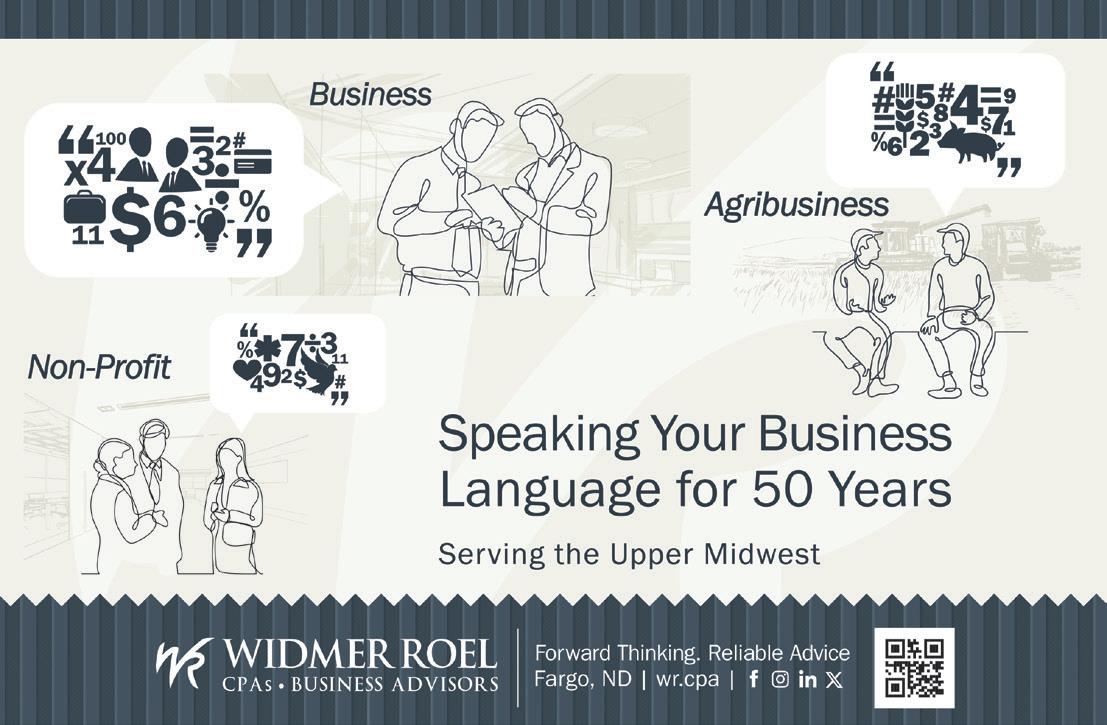
Trying to understand the scope of the incident is the first step. Then, once you understand the scope of the incident, you can better understand how to contain it. So containment is the next step. Start locking accounts, resetting passwords, removing infected devices from the network, and things like that. Then, you can start to recover. If any devices need to be cleaned or wiped, do that. If anybody's mailbox needs to be checked out, do that.
Q: IF A BUSINESS IS HACKED AND HAS INFORMATION ON CUSTOMERS THAT IS ACCESSED, HOW WOULD YOU RECOMMEND THE BUSINESS COMMUNICATE WITH THEIR CUSTOMERS?
A: For our company, we put together a formal incident response plan. We have a documented plan that whenever something happens, all of the steps for action are written out. The who, what, when, and where is all defined. I think that's a great thing that every business can have. And I think contact information for clients and customers are good things to have in your plan.
Another thing I think is really useful is a tabletop exercise for businesses. So, we bring everybody into a room, the IT people, sometimes even the finance people, sometimes even the C suite, and we run through a scenario—like a ransomware scenario for example. When we do this, a lot of good questions start to get asked.


Around 80% of businesses affected by BEC attacks did not have multi-factor authentication (MFA) in place (Cobalt: Offensive Security Services)
Q: WHAT ARE SOME OF THE MOST COMMON MISTAKES YOU SEE PEOPLE MAKE ONCE THEY'VE ACTUALLY BEEN THE TARGET OF A CYBERSECURITY INCIDENT?
A: One thing I've seen before is a hesitancy to involve cyber insurance. I think sometimes, for whatever reason, organizations are hesitant to get the insurance involved. Maybe they do this because they don't want to pay their deductible or risk their rate going up. So, they think they can kind of contain the incident themselves. That would be a big one. I think another thing is not responding urgently or ignoring certain alerts and warnings.
Q: ARE THERE ANY NEW THREATS WITH AI THAT BUSINESSES NEED TO BE AWARE OF IN THE COMING YEARS?
66% of organizations reported ransomware attacks in 2023 (Cisco Talos Blog)
A: I don't know that it's necessarily anything new right now. I think it's more of the same. One thing in cybersecurity that gets mentioned a lot is social engineering—trying to con someone into doing something that they shouldn't. And I think we're seeing AI get applied to that a lot now, and I think we're going to see more of that. Social engineering isn't new, but I think AI getting applied to social engineering is probably what we'll see. This might take the form of deep fake videos or audio, for example. People are going to try and use these to get you to send money or a password.
Global financial losses from business email compromise scams exceed $1.8 billion annually (Deloitte United States)
HIGH POINT NETWORKS highpointnetworks.com /highpointnetworks @high_point_networks /company/highpointnetworks
If you or someone you know is experiencing suicidal thoughts, mental health struggles, emotional distress, or alcohol or drug use concerns, call or text 988 Lifeline (formally known as the National Suicide Prevention Lifeline). The lifeline is available 24/7/365 and conversations are free and confidential.
Prioritizing employee wellbeing is essential. Mental health challenges, emotional stress, and struggles with substance use can affect anyone, regardless of position or experience. And, chances are, it is or will effect members of your team and impact your business.
We spoke with two individuals from The Village Family Service Center: Gabby Hagen, MS, LPCC, and EAP Clinic Supervisor and Susan Williams, MAEd, Gallup Certified Strenghts Coach and Village Trainer to get insight into how to create a work environment that prioritizes employee well being.








"As the Employee Assistance Program Clinical Supervisor at The Village, I provide counseling services at the Fargo location and support other EAP Counselors. I have a holistic view of health and work to incorporate different aspects of wellness into my counseling. My goal is to create an open and nonjudgmental atmosphere to create a safe space for clients to work on their individual goals. I received my bachelor's degree in Health, Wellness, and Fitness from the University of Wisconsin-Stout. From there, I went on to get my master's degree in Counseling from the University of Mary."

Q: WHAT ARE SOME THINGS EMPLOYERS SHOULD BE DOING TO MAKE SURE THAT THEY'RE SETTING UP AN OFFICE THAT PLACES A HIGH IMPORTANCE ON EMPLOYEE WELL-BEING?
A: Having resources available for employees, such as an Employee Assistance Program (EAP), is important. Another important aspect of this is employees' need to be reminded it's there as well, especially when there are mental health concerns that come up.
I also think training for supervisors on how to support employees when they're struggling is important.
Q: WHAT ARE SOME COMMON MISTAKES YOU SEE EMPLOYERS MAKE WHEN IT COMES TO CREATING AN ENVIRONMENT THAT IS SUPPORTIVE OF EMPLOYEE WELLBEING?
A: Not making employees aware of resources or where employees can find access to them is a mistake I see employers make.
Not having those trainings for supervisors on how to support employees is a mistake. It's not the supervisor's role to be an employee's counselor or provide any sort of therapy, but knowing how to be supportive and knowing how to handle difficult conversations is important.
It's also important to normalize things. We all go through struggles and people need to feel like they're not alone.
Q: HOW SHOULD SOMEONE BE SUPPORTIVE IN THOSE SITUATIONS?
A: I think by just listening in a non judgmental way. I think validating the employee's experience and asking them what they need is important. Asking if there's anything you can do to support them is important. A lot of times, employees, or people in general, aren't looking for someone to fix the issue—they just want to feel understood and heard and know that someone is there and that they have support.
Q: HOW ARE EMPLOYEES IMPACTED WHEN THEY AREN'T IN A GOOD ENVIRONMENT AT WORK? WHAT KIND OF THINGS DO YOU SEE?
A: We definitely see an increase in mental health concerns. A lot of people spend a very significant amount of time at work. Many people spend more time at work and
with their coworkers than they do at home with their families. So, the environment is huge. When there isn't a good environment, we see increases in depression, anxiety, and other mental health disorders. I think we see decreased productivity. When people aren't feeling supported by their employer, I think there can sometimes be resentment. I also think it can cause conflict in the workplace. I think it decreases cohesion within a team and in a workplace. There can also be more absenteeism.
A: I definitely think it's appropriate. We can't push them to tell us anything, but if you are noticing something, it's a good idea to ask, 'How are you doing?' or 'Is everything okay?' It's very possible to check in a gentle way that lets the person know that they don't have to share anything they don't want to, but that you are there and you care.
Q: WHAT ARE WARNING SIGNS EMPLOYERS
A: Any changes in the employee. Their mood might seem a little bit different or maybe they're making more mistakes. Maybe they are having a hard time balancing their workload. Maybe they're more irritable or maybe they're having more conflict with co-workers. I think there can be a lot of signs. I don't know that there are specific warning signs, but I think if you are attuned to your employees, there are a lot of times when you'll just pick up on something being a little off. They may also be very direct and tell you they're having a hard time sleeping, or that they're having issues at home, or whatever it might be.



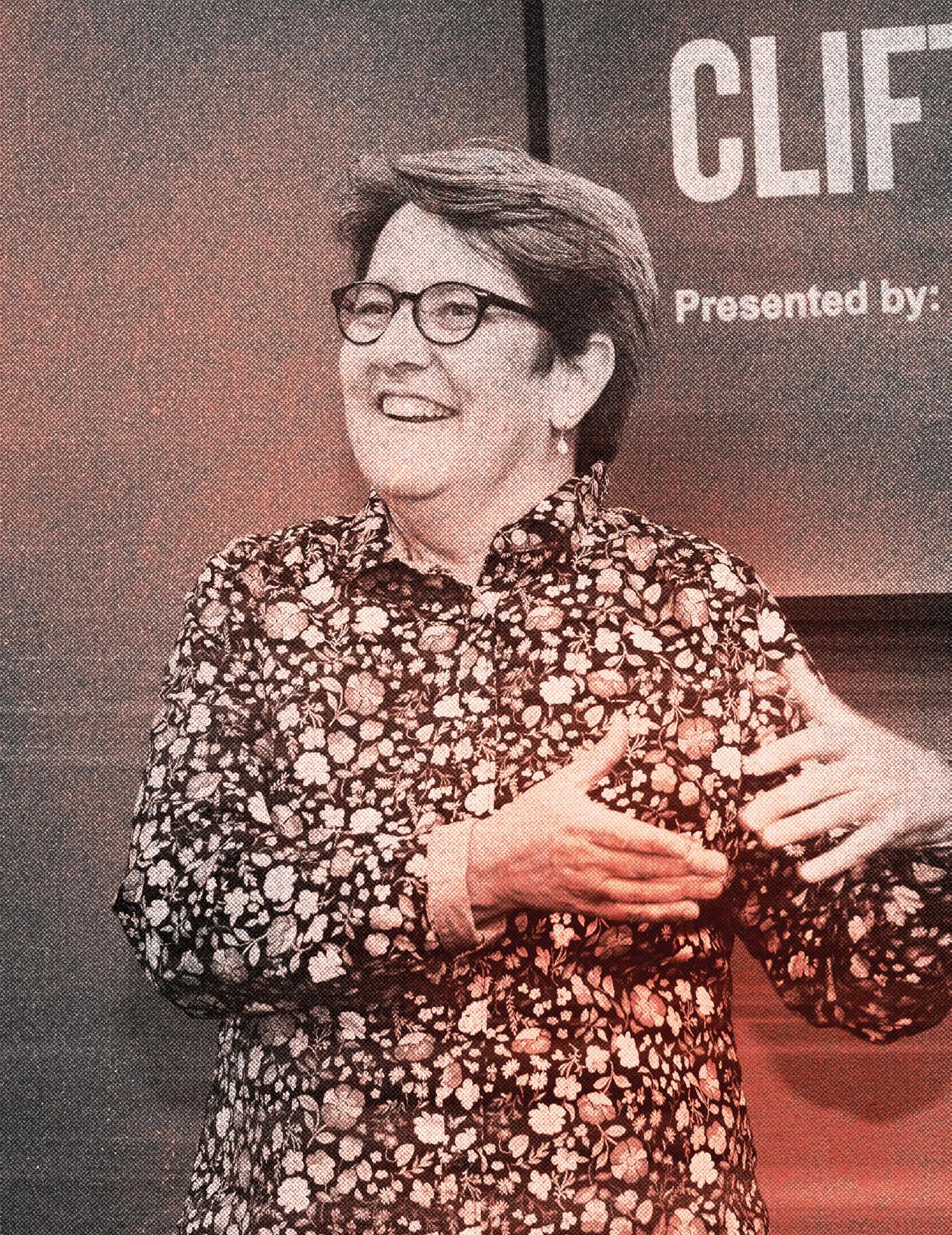
"Few things are more satisfying to me than providing the opportunity for people to learn new information and gain insight that can change their relationship with themselves, their colleagues, and the larger community. I am a GallupCertified Strengths Coach and am especially passionate about the energy and freedom a person feels when they discover their superpowers and are empowered to lean into them in all aspects of their life."

Q: WHAT PROGRAMS DOES THE VILLAGE OFFER THAT YOU WOULD RECOMMEND FOR AN EMPLOYER TRYING TO ACHIEVE AN ENVIRONMENT THAT SUPPORTS EMPLOYEES' MENTAL WELL BEING?
A: Well, certainly the employee assistance program (EAP) we offer would be very beneficial for employers. With the EAP, the organization pays a membership fee and then the organization gets free training hours to use and the number of training hours varies depending on how big the organization is.
We offer training on 40 different topics, all of which are based on human skills. A large chunk of them focus on mental health and wellness—taking care of yourself, self care, self care for the remote worker, mental health awareness, stress management, conflict resolution, emotional intelligence, communication, effective communication, and anything that
makes us better and makes us better at relationships.
We also provide, with that, the option to help supervisors deal with issues at work. This includes things like personnel not meeting expectations or not knowing how to quite get a person to level up.
But, the biggest benefit for employees is the option to use free and confidential counseling services. So, employees and members of their families get, over the course of the contract year, four sessions per household member. So, if there's a family of 4, they get 16 sessions to use any which way they please.
Included in those EAP visits are services for financial wellness. This can help employees with things like lowering their credit card debt and managing a budget. We also have an EAP service that covers intial legal consultations and then after that, the employee gets a significant discount with that law firm.
EAPs are huge for employees, and it's not just about the actual benefit of what we do for employees, it's also the knowledge that their organization cares about them and is invested in them. It says to employees, 'We're willing to pay for this service because you are valuable to us. We want you to be well. We want you to be balanced. We want you to have resources that you need, and we're willing to pitch in on it because you matter to us.'
Q: OUT OF THOSE ROUGHLY 40 TRAINING TOPICS, ARE THERE A HANDFUL YOU RECOMMEND EMPLOYERS START WITH TO MAKE SURE THEY'RE SETTING UP A GOOD ENVIRONMENT FOR THEIR EMPLOYEES?
A: Our diversity in the workforce training is really important. We need a diverse workforce. We need our
workforce to mirror our culture. When there's more diversity, there are more ideas and we solve problems faster. More diversity means better solutions. More diversity means better awareness and better relationships. Everything is better when we're not all the same—when we have different lenses through which we see things.
But better doesn't come for free. We need to figure out how to respect someone else's religion. People with different values, cultures, opinions, skin color, gender, whatever—are all equally valuable. Oftentimes, people just don't know the rules. People don't always know what's appropriate to say. So, learning what questions you should ask and how to value diversity and how to talk about it is a critical skill for the workforce.
Another training we often get requested is our training for civility in the workplace. I wrote a newsletter article for us once that talked about how I'm both heartened and discouraged that we get this training requested so often. I love to see that people want it and that they see there are issues they need help with—that's awesome. But the fact that people need someone to come into a workplace and say you can't say that to other people, or that it's really rude when you play your music so loud that everyone else can hear it, or that you can't just impose your values on other people, it's a little discouraging that you have to teach them that. These things aren't just common sense anymore. We're not all the same people. We should have diversity. We should have different opinions, and we should be able to listen to our music at work, but our neighbors should also be able to listen to their music at work. They shouldn't be forced to listen to my music—that's a simple example. This is a great training if a business is having trouble getting people to get along with each other.

Some other important ones include mental health awareness, stress management, emotional intelligence—figuring out how to read a room. How to communicate effectively—that's another big one.
For effective communication, it's important to understand things like you can't just say something once and think that someone else is going to get it or putting something in an email and thinking you're done with that. I'm a huge fan of transparent communication and letting people know everything you can let them know. That's important because then people don't fill in the gaps and make assumptions. This is also important for when you give someone a task. When you tell them something like, 'you need to have a task done by Tuesday,' you need to explain to them why because they may have someone else put something on their plate that they say is a priority and they need to be able to make a decision based on that information.
Some other trainings of ours that I think should be front and center are our trainings on burnout, compassion fatigue, self-care, and self-care for the remote worker.
We also do a number of leadership trainings for new leaders. It's

important for new leaders to delegate, build trust, and lead teams. It's important to know what makes an effective team and what the job of a supervisor is. It's important to have effective management performance reviews.
A: Eventually, their employees will go someplace else. Or worse, they'll stay and lose energy, momentum, and productivity.
It used to be that back in the day, you went to work, you did what the man told you, then you came home, and then you checked out of work. You came home to your family, and then you checked out of your family and went to work. As humans, we don't do that anymore. I have two adult daughters, and when I come to work, and am doing my job, I'm still wondering how a test at school went for one of them. When I'm home in my pajamas and watching TV, I might think of an example for a training I have to do the following day and go write it down. So, when an organization doesn't recognize that and doesn't see the whole person, they're only going to get what they
see. If they only see a cog in the wheel, they're going to get a cog in the wheel—but, no one is motivated to be a cog in the wheel. No one is motivated by being a widget that can be replaced. We're motivated by knowing that we're cared about, by doing our best, by being given opportunities to do more, and by being given opportunities to be recognized.
At a minimum, you need to be able to come into work and say to your boss, 'I'm really struggling today. I don't know if you know, but I have a history of depression, and usually, it's under control, but it's really hitting me right now, and I'm just not at my best.' And have a boss say, 'How can I help?' Instead of, 'You're going to have to suck it up because this project has to get done.' The former makes you want to fight through and stay there and get it done, and the ladder makes an employee want to walk out the door.
Q: ARE THERE ANY OUTSIDE RESOURCES OUT THERE THAT YOU WOULD RECOMMEND EMPLOYERS UTILIZE?
A: There are a ton of books out there on self-help, business, and leadership. A lot of them kind of say

Mental health is health. It's not anything different. We have treated it differently and pushed it down below because we don't, culturally, want to talk about feelings. It's awkward to say I have these dark thoughts. People don't want people to worry about them, but people should worry about us. We deserve to be worried about. So, talking about mental health is important. I personally have taken anti-depressant medication for 30 years and I also take Lipitor. If you have a mental health concern that makes you feel bad, and then you don't feel like you can talk about it, you also have a secret that makes you feel worse. Carrying a secret is hard."
-SusanWilliams,MAEd,GallupCertifiedStrengthsCoach,andVillageTrainer
the same thing. Anything by Simon Sinek is spectacular for leadership—especially when it comes to how to treat people and how to be a business that people want to work at.
Brene Brown is great for empathy. We also do an empathy training and I believe empathy is king. That's the thing that makes a difference in people's lives.
Chip and Dan Heath are also great. I really like the book "Decisive" by them. I also really like the book "Switch: How to Change Things When Change is Hard." They're both super easy to read and provide tons of examples that make sense. "Switch" is one of my favorite ones. It's all about how to get people on board with something when it's hard—this is critical for people.
There's also a book called "Crucial Conversations" by Stephen R. Covey. We have to get better at crucial conversations—those conversations where the stakes are high and emotions and opinions differ. When stakes are high, emotions are elevated, and opinions differ, you need have have a conversation—it's crucial and it's crucial that it goes well. That book is excellent and we're developing a course on it. Actually, we're going to add it to our catalog here in the fall. There's a sister book for that called "Crucial Accountability," but I recommend starting with "Crucial Conversations."
CliftonStrenghths, which used to be called StrengthsFinder, is life-changing. When an organization has a team go
through CliftonStrengths, people will never see their colleagues the same again, and they will not do business the same, and everything will improve. Profitability goes up when an organization has a strength based culture. Engagement goes up. Performance goes up. Productivity goes up. People's want to be at work goes up. Everything improves when I know what I'm naturally good at and I know what my coworkers are naturally good at as well. We can take advantage of what makes us tick.
Q: IS THERE ANYTHING ELSE YOU WANT TO MAKE SURE YOU SAY TO OUR READERS?
A: Mental health is health— mental health and physical health all wrap together. We have to get past this thing with it where we think it's something we shouldn't talk about. We should absolutely talk about it because keeping it a secret is heavy and it's hard. It's taxing, it's exhausting, and it doesn't help. You can keep the secret, but how does that help you? It doesn't help you. We have to be okay talking about it. We have to be okay not knowing all of the answers. THE VILLAGE FAMILY SERVICE CENTER thevillagefamily.org /thevillagefamily @thevillagefsc @VillageFamily





BY BRADY DRAKE

rofessional burnout has become an increasingly common issue across industries. Characterized by chronic stress, exhaustion, and a sense of disconnection from one’s work, burnout not only affects individual well-being but also impacts productivity and organizational culture. As employees grapple with growing workloads, blurred work-life boundaries, and mounting pressure to perform, the risk of burnout rises.
In this article, we spoke with three mental health professionals about professional burnout, it's causes, coping mechanisms, and more.






LCSW, Solace Counseling
Professional burnout is when we feel physically, mentally, and/or emotionally drained from our work.
LPCC, New Story Counseling
There are many signs/symptoms, and it may look very different from person to person. Generally speaking, if you are unable to manage the stress from your professional role, you may be experiencing burnout or signs of fatigue/exhaustion. You may experience frustration, a sense of hopelessness or helplessness, a sense of "checking out" or losing interest and empathy for your role or the people you work with/for. You may experience brain fog. You may dread going to work. You may become irritable or anxious in other relationships, even those that aren't work related. You may become preoccupied with work and find you are "taking it home with you." You may experience disrupted sleep, mood dysregulation, existential crises, or feel unfulfilled. While your experience may vary, in general, you are not able to process through and manage the stress or tasks you are responsible for, resulting in overworking and/or a general sense of getting behind or overwhelmed. You don't feel refreshed by your self-care or other life roles and return to your professional role with diminished capacity. While this can happen quickly, it can also happen very slowly over time, which can make it harder to notice or detect until you are well into your experience of burnout.
MA,LPCC, LMAC, Willow Tree Counseling
Professional burnout is when we experience physical, mental, and emotional exhaustion. Burnout symptoms can include increased negative thoughts about work, increased stress and tension, withdrawing from others at work, not caring if we arrive to work on time, and difficulty initiating tasks at work. Burnout can also present as a decrease in care and concern for our co-workers and increased feelings of not being good enough in the various roles in our personal and professional lives.


LCSW, Solace Counseling
Often this is a result of many things which can include too many hours at the office, too many hours working on work outside of the office, a lack of passion for the work we do, and/ or a lack of praise, appreciation, and/ or satisfaction from the work we do. It is so common to see professional burnout happen when someone is working in the office 40+ hours and finds themselves also bringing their work home after hours.

LPCC, New Story Counseling
In therapy we have a classic phrase: "It depends." And it really does. But again, generally speaking, I would say taking on more responsibility or tasks than you can reasonably manage will eventually lead to burnout. That might be taking on too many work hours, taking on too many high priority tasks, overseeing too many subordinates, among other things.
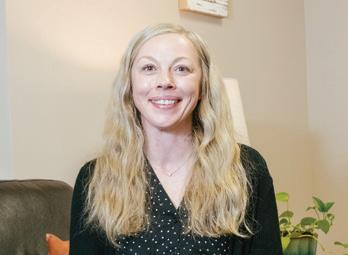
MA,LPCC, LMAC, Willow Tree Counseling
Causes of professional burnout can include the general culture of the workplace, feeling undervalued, feeling overworked, feeling alone or that you are not part of a team, not taking care of your physical health, not getting enough sleep, not taking time to spend time with those you love, and not feeling like you are effective in your role.
LCSW, Solace Counseling

Find ways to genuinely care for your employees. Recognize they are incredible human beings with wonderful talents that have physical and emotional needs. Try and create an environment that you want to come work at. What a bummer to create a business and not want to go to your own business. Love it, make it fun, and fuel your passion!
LPCC, New Story Counseling
This is an excellent question and at
the heart of the problem of burnout. Ultimately, the work setting is responsible for professional burnout. My number one suggestion is to reduce weekly work hours. Burnout is often exhaustion from being overworked. The United States still averages quite higher than other developed countries on hours worked per week. This is related to burnout and job attrition. My second recommendation is to pay your employees a living wage with supportive benefits. If your employee leaves work, goes home, and struggles to pay rent, pay medical bills, pay childcare, or pay to fix a vehicle, they will experience elevated stress levels that will contribute to burnout. There are many factors that contribute to prevention of burnout, such as
a supportive work culture, a safe work setting, adequate training, etc. However, work pay and hours cannot be overlooked.
MA,LPCC, LMAC, Willow Tree Counseling
Check in with your employees. Ask them what goals they have, both professionally and personally, and engage in conversation to see how you can support them in attaining those goals. Take a step back and evaluate the workload demand. Ask yourself if the expectations are realistic for a majority; if not, re-evaluate your expectations of your employees.

strategies do you recommend for preventing burnout? ?
LCSW, Solace Counseling
We offer many strategies for both our administrative and clinical staff to prevent burnout. Some of the important items are ensuring clinical staff are not seeing too high of a caseload. We allow clinicians to pick the number of openings they would like to have in their schedules, in order to accommodate work/life balance and prevent burnout. We also offer incredibly flexible scheduling for clinicians that allows them to work the hours that fit their lifestyle. For example, some clinicians come in late and leave early and work five days a week and that's balance for them while other clinicians see all of their clients in three days, which allows them to be off the other four days per week. Additionally, we offer flexible scheduling for administrative staff, close early on Friday's, and to date, have not denied any leave or PTO requests.
We also have a culture where praise is welcome and encouraged. We have little cards called "Solace Shout Outs" where employees from every level write each other a note of appreciation. For example, some I have seen lately are a "thank you" for doing the other person's weekly cleaning task, a "thank you" for listening after a difficult session, and a "thank you" for bringing in an office treat.
Our break room is full of snacks and drinks for the staff to enjoy, along with funny jokes on the fridge, and pictures of employees and their families on the walls.
We offer company outings where staff can come alone or bring their family. We have had a picnic at a park with bouncy houses and a clown who made balloon animals, we have met at local restaurants, and we recently rented out a showing at the movie theater so employees could bring their families and feel okay with little kids running around.
LPCC, New Story Counseling
Short answer: Set boundaries. Long answer: It's complicated and can look different for everyone. In our society, the professional or career identity is highly emphasized and often prioritized over other life roles or identities, which makes it very difficult to recognize and/or prevent burnout. Burnout is a systemic problem that is difficult to fight on an individual level. Many people don't have the privilege to set boundaries or control what is being demanded of them in the workplace or professional setting.
MA,LPCC, LMAC, Willow Tree Counseling
Ways to prevent burnout are often the things that we don't feel we have time for. It is recommended that you ensure you are getting enough sleep, eating regularly and choosing options that fuel your body, limiting caffeine intake, and exercising. However, there are additional ways to prevent and combat burnout. Evaluating what needs to be done, determining what can wait, and saying 'No' to tasks or invitations help manage our stressors. Sometimes we need to also take a look at the types of thoughts we are experiencing and identify ways to shift our language to reduce negative appraisal of tasks. For example, having a thought such as, "I am never going to get this done in time," can leave a person feeling defeated and decrease productivity. Replacing that thought with a new thought that decreases feelings of defeat or helplessness can shift our emotions and desire to engage in tasks.
Check out our sister publication Bis-Man INC! for more tips on how to prevent burnout.
Scan the QR code to read the full story!

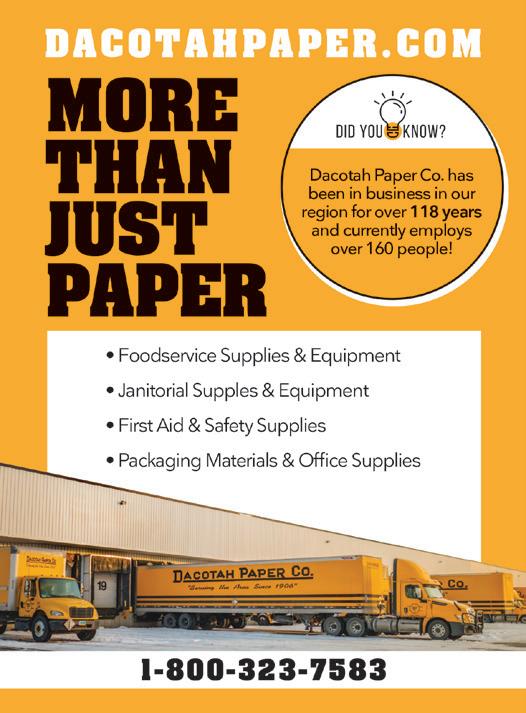



LCSW, Solace Counseling
We offer mental health counseling services at Solace Counseling and specialize in working with the professional population who is experiencing burnout. There are also many other mental health offices in our community that would be happy to treat you. Finding a therapist is all about finding the right fit for you. If you go to one therapist and don't feel like they were the right fit, try again. The best predictor of whether therapy will be effective or not is the relationship between the client and the therapist. The modality, school the clinician graduated from, and years of experience all do not matter as much as the relationship between the client and clinician. Do you feel like the clinician is rooting for you, not judging you, and do you feel you can show up authentic? If your answer is yes, you might have found a good fit!

LPCC, New Story Counseling
Work-life balance is huge. Unfortunately, it's a vague concept that would be defined differently from person-to-person. Again, we tend to over-emphasize the value placed on the career identity over other identities. This skews the expectations for what work-life balance looks like. One simple way for employers to honor personal lives over work is to provide robust leave policies and benefits. Allow employees to take leave for personal reasons. Don't create barriers for employees to attend medical appointments, family events, vacations, their child's soccer game, etc. Expect and plan for coverage when your full-time employees are out on leave and approve leave requests.

LCSW, Solace Counseling
Exercise, yoga, talking it out with a friend or family member, quiet time, and prayer are all great ways to assist in coping with burnout.
LPCC, New Story Counseling
Prevention for burnout is much easier to address than dealing with burnout once it has already happened. Notice warning signs and react early. Set limits with your employer on what you can and cannot do. Raise concerns you have to your direct, HR, or the appropriate manager. Process through your stressors with trusted friends, co-workers, family, or professionals. Set boundaries, such as leaving at the scheduled end of your shift vs.
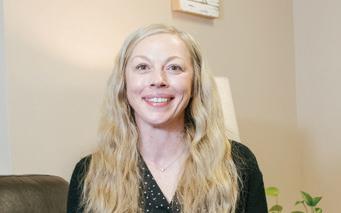
MA,LPCC, LMAC, Willow Tree Counseling
Work-life balance is important in helping mitigate burnout. Each person is going to approach the workplace differently. One employee may have goals of increasing their income to

working such as being the hardest or most valuable worker, being available 24/7, exceeding expectations, going the extra mile, or going above and beyond. Assign responsibility where it belongs instead of internalizing exhaustion as a personal failure or an incompetency.
How do you see the issue of

LCSW, Solace Counseling
It seems to me the topic of professional burnout is being addressed far more today than it was 10 years ago. When I think of my parents and grandparents it was a badge of honor to say they worked 60+ hours a week. We are starting to get away from that and people are focusing more on finding fulfillment in both the workplace and at home.

burnout evolving in the next 5-10 years?

LPCC, New Story Counseling
The immediate outlook is grim. Salaries have not increased as rapidly as the cost of living, cost of childcare, etc. I expect professionals will feel pressed to work longer hours and have less leisure time and resources to take good care of themselves. For professional burnout to improve, the workforce needs to have fewer demands, better benefits, and higher compensation. As a society, we have

to place more value on community, hobbies, families, leisure, and accommodations for disabilities than we do on work output.
MA,LPCC, LMAC, Willow Tree Counseling
Professional burnout is not something that is going to disappear and it is our job to learn how to better manage it and support ourselves and others when it is present.
What mental health resources, apps, ect. do you recommend for combatting professional burnout?
LPCC, New Story Counseling
Professional burnout cannot be welladdressed on an individual, employee level. Burnout is the employer's responsibility and requires companies
MA,LPCC, LMAC, Willow Tree Counseling
There are so many resources available to combat professional burnout. There are apps, both free and fee-
access to counseling for free. Medical providers can also provide assistance in exploring medication and other



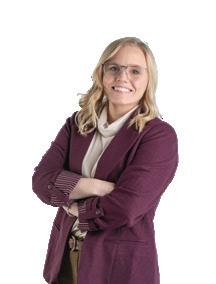
Megan Suedbeck: When I'm feeling overwhelmed with a large workload or too many things going on at home, I make lots and lots of lists. I break up each task I need to get done and soak in the dopamine I get from checking each item off my list.

Tori Konrady: I prioritize working out two or three mornings a week, which helps me mentally prepare for a good day. I like to step away from my desk, take advantage of my lunch break, and unplug. During the day, I

Austin Cuka: I try to always keep my momentum going to fight burnout and stress because, most of the time, it’s all happening in my head. I find ways to

Ben Buchanan: Making a list of my important tasks and tackling them one at a time helps put my work stress at ease. Learning a new type of software or tool
I combat burnout by giving myself time to recharge. I meditate by following a guided meditation and focusing on my breathing. I also go for long walks with my dog and listen to a good podcast. It's important to give yourself time to reset. In the long run, you will be more productive.
listen to a variety of podcasts to keep my mind engaged in an additional way.
Also, keeping my weeknights full of plans is important to me!
compete against myself and work to be better every day. I also avoid taking on more than I can handle at one time and just focus on the task in front of me.


Dave McSparron: I like to think I'm much better at combating work stress than I was when I was younger. It can be a difficult thing to navigate and can mess with family relationships, overall attitude, and productivity.
Golf has been a relief valve for me for many years. When stress builds in the winter months, I turn to music. Listening

Paul Hoefer:
I try to exercise, take vacations, do things with friends, attend live music and sporting events, and a drink never hurts!
helps keep me engaged and avoid burnout. When all else fails, I rewatch the hit sitcom "Frasier" while eating salty snacks.
to, rehearsing, and performing music is quite effective for me. It has been a big part of my life and always leaves me refreshed and reinvigorated. Hobbies, time with family, laughter, and exercise can all be tools for stress and tension management.
The hardest thing for me to learn has been how to recognize when that stress is affecting me before it becomes a problem and to consciously take steps to manage it.

Al Anderson:
I set aside some time to reflect on the successful projects we have completed for our clients.

Kellen Feeney: One thing to look out for is carpal tunnel syndrome. It's recommended that you take a 10-minute break from typing every hour.
For your circulation, you're going to want to get up out of your chair and walk around

Ty Betts: I make sure to drink plenty of water, stay on top of healthy routines as much as possible, take breaks when needed, and try to detach from workplace thinking when not at work.

for 10 minutes every hour.
Lastly, your computer screen can be a big strain on your eyes, so it's recommended you step away for about 10 minutes every hour.

John Stuber: I stay involved in various hobbies, including walking, biking, and hunting, and top it off with a glass of wine every evening.

Brady Drake: For me, it's super important to get moving before I come to work in the morning. Whether it's a walk, run, bike ride, swim, or a weightlifting and stretching session, moving helps me reset my mind and keeps me in a positive mindset.

Kim Cowles: During my free time or while on PTO, I try to disconnect from work-related communications and screens to give my mind a break.


Sam Winter: I have clear boundaries between work and home life, and a dedicated workspace if I work from home. I only respond to messages and emails that are both urgent and of high importance.
Also, I think it's really important to take time off. When I do take time off, I like to center it around something active. In my opinion, a vacation does no good if you spend your time away trashing your body and not sleeping the way you should.

Josiah Kopp: For me, combating work stress and burnout comes from a mental approach. When I am not in the office doing photo shoots, I keep myself inspired and energized by doing creative and
Jessica Ventzke: I create focus lists with attainable goals each day, which help me identify what I need to get done for the week. This allows me to properly manage my time and avoid getting overwhelmed with too many things. Organization is key!
I seek help from my teammates and try to foster a work environment that is supportive and communicates openly. I prioritize my workload and break my workday into smaller, focused segments. I also take breaks throughout the day to stay sharp and recharge.
challenging shoots in my free time. When it comes to tackling any given project, I am reminded of something my dad always told me—a blue-collar worker for 33 years: 'Do everything as if you're doing it for the Lord.'

Jenny Johnson: One helpful strategy that has worked well for me is time blocking, which helps me organize projects and avoid jumping from task to task. I also make sure to include

Nick Schommer:
I combat work stress and avoid burnout through golf and hunting.

Mike Dragosavich: I believe the #1 reason people get burnt out is because they are overwhelmed and not confident in what they are doing. A way to cure this is to pride yourself on becoming more technically resourceful in the thing that is leading to your burnout.
If I'm a salesperson and I'm burnt out from the grind of selling, it's usually because I'm not excited or confident that the work is creating internal value for me. So get on YouTube and Google, and start learning as much technical information about sales processes, tips, tricks, new trends, and psychological approaches, and see what others are doing in the space. This will make you more resourceful.
Being more technically resourceful will:

enjoyable tasks in my workday and listen to something I find enjoyable to help me stay focused. Additionally, I've set a boundary to leave work at the office and refrain from checking work communications when I'm at home with my family.
These activities allow me to disconnect from work, clear my mind, and recharge, helping me maintain a healthy work-life balance.
4. Help you gain a new perspective on the tasks burning you out and start seeing them as opportunities.
As soon as you think you already are resourceful, I will tell you right now you are not even close. So humble up and go be a nerd!
My Example:
Accounting work burns me out because I don't have a passion for it. As soon as I chose to watch and research accounting vs just sitting on Netflix it made me instantly see accounting tasks differently. I found software, tools, Reddit message boards, youtube videos, and so much more that made me excited about things like spreadsheets. YUCK. I watched 5 hours of tips and tricks for accounting and how to use Google Sheets better and all of a sudden spreadsheet work was fun to me because I found all these new ways to create fast workflows, save time on recurring tasks, and even felt proud of my work.

gain better results, and generate new ideas when

If I don't do that I feel burnt out because it feels like a never ending boring task that is like an assembly line.





nytime a local business expands, it’s a cause for celebration. Flint Group’s recent expansion to Kansas City is no different. As a leading marketing and communications agency, Flint Group has consistently demonstrated a commitment to innovation and growth, both in its creative approach and in its geographic footprint. This latest move into Kansas City’s vibrant Crossroads Arts District marks a significant step in the company's journey, opening new opportunities for collaboration and client engagement in a dynamic market.
We sat down with Jodi Duncan, President of Flint Group, to discuss what this expansion means for the company, the unique opportunities Kansas City presents, and how Flint Group plans to bring its distinctive brand of creativity and strategic thinking to a new region.
with

Q: Beyond the initial hiring plans, what specific growth strategies do you have in place for the Kansas City office? Are there particular sectors or types of clients you aim to target more aggressively?
A: Kansas City provides a more centralized location to make additional connections with businesses that would fit well as clients. We currently have clients throughout North America, so location isn’t a huge factor for us, but the new space in Kansas City broadens our footprint a bit.
We enjoy hosting clients for everything from annual planning meetings to dealer summits. Inperson meetings really help build understanding and strengthen relationships, which is a big part of what makes Flint Group different than other agencies. We dig into whatever industries our clients are in, taking extra time to study and learn about who they are targeting and why. Then

we like to create opportunities to get face-to-face with stakeholders to understand the nuances of their organization and situation. The new space provides a more centralized location for these gatherings, allowing us to better accommodate client needs while maintaining the aspects that make us unique.
In terms of industries served, we really cover a wide gamut. Flint Group has the most depth in manufacturing, health care, and financial services. These are some of our longest relationships, many of which span decades—a rarity in our industry. We have experience in higher education, technology, energy, and local/ retail, as well. There are a number of businesses in Kansas City that fit our strengths, and we will be pursuing opportunities across all the industries we serve. We have already secured a contract with a prominent higher education institution in the region and are in talks with several manufacturers in the area.
Q: Given that AdFarm is also based in Kansas City, how do you see the two agencies collaborating or complementing each other?
A: The beauty of the AdFarm/Flint Group relationship is that we manage our businesses separately but can leverage each other when it makes sense. AdFarm is laser-focused on clients that are in the agricultural space, however, they may require a skill set or expertise that is deep on the Flint side, and vice versa. An example of this is channel marketing programs. Flint has depth and expertise in this area that AdFarm taps into when appropriate.
In addition to channel marketing, we share a number of talents and resources across the RR46 family of businesses including audio/visual, artificial intelligence, and digital development. This allows us to cultivate excellence in every aspect of the marketing process and apply it when necessary. We also share

tools and subscriptions that enhance both of our offerings. This flexibility and collaboration allow us to push forward with an “unapologetically clientdriven” approach that sets us apart from other agencies.
Q: You mentioned that Kansas City aligns with Flint Group's Midwest roots and values. Can you explain?
Q: What challenges do you anticipate as you establish Flint Group in the competitive Kansas City market?
A: The agency business is challenging no matter where you go. It’s very competitive, and KC is home to many successful agencies. That was an important consideration for us. We believe that we offer something different. We’re very business-minded and results-focused. We’re considered a large agency, but we act small. We spend time considering how we would want to be treated as a client and do our best to be that kind of partner.

A: We’ve worked with multimillion-dollar international companies headquartered in the Deep South and momand-pops from just down the street. We frequently hear from clients of all shapes and sizes how refreshing it is to work with our agency. We attribute this to our Midwest roots and our desire to really dig in and solve problems. As an agency, we focus on helping clients reach their goals as effectively as possible—whether that’s a website redesign or a creative digital campaign. We consider ourselves “unapologetically client-driven,” in search of the ideal solution for each client’s unique needs. We just feel that’s the Midwest way of doing things.
KC fits seamlessly into this philosophy. Like the Red River Valley, there is a deep connection with the land through a healthy agricultural and industrial community. We see our values reflected in the straightforward, downto-earth people. They are proud of their educational institutions, their unique culture and their food. Sound familiar?

Kansas City isn’t more challenging than any of our other locations. It’s all about the people we have in place. Where we are isn’t nearly as important as WHO we are.
Q: With plans to expand the team, what qualities or skills are you specifically looking for in potential hires? How do you plan to attract top talent in such a competitive market?
A: Our philosophy has always been “Hire good, smart people and growth will happen.” A good attitude and curiosity will always result in success at the agency. We can teach skills, and we invest a generous amount in employee education and training, but, at the end of the day, an innate drive to dig deep, solve problems, and work collaboratively makes for a successful team.

With the addition of our Kansas City location, we open new options for our employees. We employ a younger workforce that sometimes just wants to spread their wings and try a new city. We’ve embraced flexible work environments, but we recognize that some aspects of marketing just work better when we get together in person. The new location gives employees a chance to enjoy our famous Flint office culture in a new environment. We envision employees being able to seamlessly move between any of our primary locations—Fargo, ND; Duluth, MN; and Kansas City, MO—and still feel right at home.
Additionally, the new location allows us to cast a wider net to attract more diverse talent. Agency work appeals to individuals who are curious and open-minded. Flint Group has built a collaborative culture that encourages empowerment and taking initiative. We offer a relationship-based approach to marketing that is unique in the Kansas City agency arena. We feel this will help us attract the right talent in Kansas City to support our clients from across the country.


By Grant Ayers

Regardless of your experience level in the business world, gaining additional knowledge is always valuable. Whether you're an experienced business owner or just starting out, take the opportunity to learn about some of the most effective growth hacks that can enhance your business expertise.
In this article, we will explore ten growth hacks focused on optimizing business operations and maximizing efficiency. As a business owner, streamlining processes and minimizing costs are crucial to improving your bottom line and sustaining long-term success.
In the pursuit of growth, the path to success often lies in the details. Conducting a comprehensive process audit is a fundamental step that can yield substantial rewards for your business. This strategic endeavor involves a deep dive into your operational framework, shedding light on bottlenecks, inefficiencies, and hidden opportunities for improvement.
The Audit Unveiled
Embarking on a comprehensive process audit requires a systematic approach that encompasses every facet of your business operations. Begin by assembling a crossfunctional team with representatives from various departments. This
collaborative effort ensures a holistic view of your processes, drawing from diverse perspectives.
The audit itself involves meticulously mapping out each step of your workflows, from inception to completion. Pay close attention to handoffs, decision points, and delays. This granular analysis unveils bottlenecks that hinder efficiency and areas where tasks might be duplicated or redundant.
As the audit progresses, inefficiencies that once lurked in the shadows come to light. Perhaps there
are manual tasks that could be automated to reduce errors and free up valuable time. Maybe certain steps in your processes lack clarity, leading to confusion and slowdowns.
By pinpointing these inefficiencies, you open the door to transformative change. Consider the time and resources that could be saved by streamlining workflows and eliminating redundant steps. This newfound efficiency not only boosts productivity but also positions your business for scalability and growth.
With a clear understanding of your current processes and their pain points, it's time to roll up your sleeves and start optimizing. Collaborate with your team to brainstorm innovative solutions that address the identified inefficiencies. This might involve adopting new technologies, revising protocols, or reallocating resources.
As you implement changes, keep a close eye on key performance indicators (KPIs). Measure the impact
of your optimizations in terms of time saved, increased output, and enhanced quality. This data-driven approach not only validates your efforts but also informs further refinements.
A comprehensive process audit isn't a one-off endeavor; it's a catalyst for fostering a culture of continuous improvement within your organization. Encourage your team to remain vigilant for opportunities to
enhance efficiency and effectiveness. Create a feedback loop that allows for ongoing evaluation and refinement of your processes.
Moreover, the process audit sets the stage for future growth initiatives. As your business evolves, your processes should evolve in tandem. By cultivating a culture that embraces change and innovation, you position your business as an agile and adaptive force in your industry.
In today's rapidly evolving business landscape, staying agile and adaptable is essential for sustainable growth. Embracing cloud-based solutions can be a game-changing growth hack that not only enhances your operations but also positions your business for success in the digital age. Let's delve deeper into how migrating to cloud-based platforms can drive enhanced scalability, accessibility, and cost-effectiveness while transforming the way you collaborate and manage data.
Traditional on-premises infrastructure often requires significant investments in hardware and IT resources when your business expands. Cloud-based solutions, on the other hand, offer unparalleled scalability. Whether your business experiences sudden spikes in demand or steady growth over time, cloud platforms can effortlessly adjust to accommodate your needs. You can scale up or down as required to ensure your IT infrastructure seamlessly aligns with your business growth trajectory.
One of the most significant advantages of cloud solutions is the accessibility they provide. With a secure internet connection, you and your team can access critical business data, applications, and tools from virtually anywhere in the world. This remote accessibility empowers your workforce to be productive whether they're in the office, on the road, or working from home. As a result, you can maintain operational continuity and collaboration regardless of physical location.
Enhanced Collaboration and Communication: Cloud-based platforms facilitate real-time collaboration among team members, even when they're geographically dispersed. Shared documents, collaborative tools, and communication apps enable seamless interaction and knowledge sharing. This level of collaboration is especially valuable for businesses with remote teams, branch offices, or partners located across

“Picture not needing to keep that messy shoebox of receipts, a cluttered desk of papers, or the hassle of delivering files to your accountant's office! As a fully virtual business from day one, I've experienced firsthand the immense value of embracing cloud-based technology in your business. I love that it allows my team to work efficiently and streamline processes, serve clients across the USA, and collaborate remotely. We’ve also seen how cloudbased solutions helped our clients and peers in significant ways. There are so many industry-specific options available now too, I highly recommend seeing what’s out there!”
- Maddie Craig, Founder of Blue Cyhper Cypher Bookkeeping
different regions. By breaking down communication barriers, cloud solutions foster a more connected and productive work environment.
Efficient data management is critical for any growing business. Cloudbased solutions provide centralized data storage, making it easier to organize, access, and manage your valuable information. Additionally, many cloud providers offer robust security features, including data encryption, regular backups, and multi-factor authentication. These measures help safeguard your business data from potential threats to ensure compliance with data protection regulations and help you build trust among your customers.
Migrating to the cloud can lead to substantial cost savings. Traditional on-premises infrastructure requires significant upfront investments in hardware, maintenance, and ongoing IT support. Cloud solutions operate on a subscription-based model, allowing you to pay for the resources you use. This pay-as-yougo approach eliminates the need for costly hardware upgrades and reduces the burden of managing complex IT infrastructure. The financial flexibility offered by cloudbased solutions enables you to allocate resources strategically, invest in innovation, and focus on core business activities.
Embracing cloud-based solutions is more than just a technological shift—it's a strategic growth hack that can revolutionize the way you operate and position your business for success. By harnessing the scalability, accessibility, and costeffectiveness of cloud platforms, you can streamline operations, enhance collaboration, and empower your business to thrive in a dynamic and competitive market. As you embark on this digital transformation journey, remember that the true value of cloud solutions lies in their ability to unlock new opportunities and fuel your business growth for years to come.

“One of the first things I do when we partner with a new business is look at their financial processes! We always want to ensure we thoroughly understand them or help them create new streamlined ones. It’s also a good way to find bottlenecks or opportunities for improving things as well. This way your team clearly understands tasks, makes training easier, and ensures all parties stay on the same page.”
- Maddie Craig, Founder of Blue Cyhper Cypher Bookkeeping
Rooted in the principles of efficiency and continuous improvement, lean methodology offers a structured approach to eliminating waste, optimizing resource allocation, and enhancing overall productivity. Let's delve into the specifics of how you can implement lean principles to drive growth within your organization.
Lean methodology places a strong emphasis on identifying and eliminating various forms of waste. These wastes can manifest in various ways, including excessive inventory, unnecessary waiting times, overproduction, defects, and more. By conducting a thorough assessment of your processes, you can pinpoint areas where waste occurs and implement strategies to minimize or eliminate them. This leads to cost savings, increased efficiency, and streamlined operations.
Lean methodology encourages businesses to optimize resource allocation based on demand and value-added activities. This involves aligning resources with the most critical processes that directly contribute to delivering value to customers. By reallocating resources from non-essential activities to those that have a direct impact on customer satisfaction, you can enhance the quality of your products or services while maintaining cost-effectiveness.
One of the cornerstones of lean methodology is the commitment to continuous improvement. Encourage a culture where employees at all levels are empowered to identify
opportunities for enhancement. Regularly gather feedback from your workforce and involve them in the improvement process. This can lead to innovative solutions, better processes, and increased employee engagement.
Visual management tools, such as Kanban boards and value stream maps, play a crucial role in lean methodology. These tools provide a visual representation of workflows, helping teams identify bottlenecks, track progress, and make informed decisions. Visual management fosters transparency, enhances communication, and empowers teams to collaborate effectively in improving processes.
Standardizing processes ensures consistency, reduces variability, and facilitates continuous improvement efforts. Develop clear, documented procedures for key activities to create a baseline for measuring performance and identifying areas for enhancement.
Lean methodology encourages collaboration across departments and functions. By breaking down silos and promoting cross-functional teams, you can gain diverse perspectives and ideas, leading to more holistic and effective solutions to complex problems.
Set key performance indicators (KPIs) to track progress and measure the impact of lean initiatives. Regularly analyze KPI data to assess the effectiveness of your lean efforts and identify areas that require further attention.
Educate your employees about lean principles and methodologies. Provide training to help them understand the core concepts and techniques.


In today's dynamic business landscape, strategic outsourcing has emerged as a potent growth hack, enabling businesses to optimize operations, enhance efficiency, and drive sustainable growth. One particularly impactful avenue is outsourcing non-core functions, a strategy that empowers business owners to concentrate their efforts on what truly matters—core competencies and strategic initiatives.
The rationale behind outsourcing non-core functions is rooted in the principle of resource optimization. While essential, functions like IT support, payroll processing, and customer service often demand substantial time, effort, and resources. By entrusting these functions to specialized service providers, businesses unlock several key benefits:
Enhanced Focus on Core Competencies: By shedding non-core responsibilities, business owners and their teams can channel their energies into activities that directly contribute to their competitive advantage. This laser focus fosters innovation, accelerates growth, and propels the company ahead of competitors.
Cost Savings: Outsourcing can yield significant cost savings. By leveraging the expertise and economies of scale offered by specialized service providers, businesses can access top-tier resources without the burden of hefty investments in infrastructure, training, or technology.
Outsourcing partners are experts in their respective fields. This ensures that crucial functions, such as IT support or customer service, are handled by professionals with a deep understanding of industry best practices and evolving trends.
Scalability: As your business expands, outsourcing facilitates seamless scalability. Service providers can quickly adjust their support to accommodate increased demand, allowing your business to grow without the constraints of internal capacity.
Risk Mitigation: Specialized providers often have robust risk management strategies and contingency plans in place. This reduces the impact of potential disruptions and ensures business continuity, even in challenging circumstances.
To successfully implement this growth hack, consider the following steps:
Begin by identifying functions that are not directly tied to your core competencies. These could include HR, accounting, customer support, and more.
Select
Carefully evaluate potential outsourcing partners based on their track record, expertise, and alignment with your business values. Transparent communication and a shared vision are essential.
Establish well-defined expectations, deliverables, and key performance indicators (KPIs) with your outsourcing partners. Clarity in these areas ensures accountability and measurable outcomes.
Seamless Integration:
Smoothly integrate outsourced functions with your internal processes. Maintain open channels of communication and encourage collaboration between your team and the outsourcing provider.
Regular Performance Evaluation: Continuously monitor the performance of your outsourcing partners. Regular assessments ensure that the expected benefits are being realized and provide opportunities for refinement.
In a business landscape characterized by rapid change, the ability to adapt and innovate is paramount. Outsourcing non-core functions empowers you to do just that by freeing up resources and unleashing your team's potential. As you navigate the path of strategic outsourcing, remember that success lies in selecting the right partners, fostering strong collaborations, and maintaining a relentless focus on your core competencies. By doing so, you'll position your business for sustained growth and a competitive edge in the market.

Investing in employee training and development is a growth hack that holds the potential to transform your business from within. By nurturing your workforce and providing them with opportunities to enhance their skills and knowledge, you're not only investing in your employees' future but also in the future success of your company.
To truly harness the benefits of employee training and development, it's essential to craft a well-thought-out strategy. Start by identifying the specific skills and competencies that are crucial for your business's growth. Consider both technical skills related to the job and soft skills that contribute to effective teamwork, communication, and leadership.
Recognize that each employee has a unique set of strengths, weaknesses, and career aspirations. Design training and development programs that cater to individual growth paths. This personalization not only demonstrates your commitment to their professional journey but also maximizes the impact of the training.
The world of business is dynamic and ever-evolving. Encourage a culture of continuous learning within your organization. Provide access to online courses, workshops, webinars, and industry conferences. This not only keeps
employees up-to-date with the latest trends and advancements but also fosters a sense of intellectual curiosity and adaptability.
As your business evolves, certain roles may change or new opportunities may arise. Use training and development as a means to upskill or reskill employees. This not only enhances their job satisfaction but also ensures that your workforce remains agile and versatile.
Establish clear metrics to measure the effectiveness of your training programs. Monitor key performance indicators (KPIs) such as productivity, customer satisfaction, and employee engagement before and after training. Celebrate the successes and use the data to refine and optimize your training strategy.
Training and development extend beyond formal programs. Create an environment where employees are encouraged to share knowledge, mentor one another, and engage in cross-functional collaboration. A culture of growth promotes innovation, empowers employees, and contributes to a harmonious and motivated workforce.
A commitment to employee training and development enhances your reputation as an employer of choice. Potential hires are drawn to companies that invest in their professional growth. Furthermore, your existing employees are more likely to stay with your organization when they see a clear path for advancement and a commitment to their development.
The impact of investing in employee training and development extends far beyond the individual. As employees grow and develop, they bring new ideas, perspectives, and efficiencies to their roles. This ripple effect can lead to process improvements, innovative solutions, and a collective drive toward achieving your business's growth objectives.
Incorporating this growth hack into your business strategy signifies a long-term commitment to nurturing your most valuable asset: your workforce. By fostering a culture of continuous learning and professional development, you're not only investing in individual employees but also sowing the seeds for sustained business growth and success.


Effective inventory management is a cornerstone of successful business operations. Let's dive deeper into this growth hack and explore how optimizing inventory management can contribute to strategic expansion.
The Challenge of Inventory Management
Finding the right balance between excess stock and stockouts is a perpetual challenge for businesses. Overstocking ties up valuable capital, increases storage costs, and risks obsolescence, while understocking can lead to missed sales opportunities, dissatisfied customers, and damage to your brand reputation.
Embracing data-driven techniques is pivotal in navigating this challenge. Advanced inventory management systems utilize historical sales data, demand forecasting, and real-time analytics to guide decision-making. These insights empower you to make informed choices about what, when, and how much to order, minimizing excess inventory while maintaining an optimal level to meet customer demand.
What are the Benefits of Optimized Inventory Management?
Improved Cash Flow: By reducing excess inventory, you free up capital that can be invested in growth initiatives, innovation, or other strategic areas of your business.
Enhanced Customer Satisfaction: Maintaining optimal stock levels ensures you can fulfill customer orders promptly, which minimizes stockouts. This leads to higher customer satisfaction and loyalty.
Reduced Holding Costs: Storing excess inventory incurs expenses related to storage, insurance, and potential obsolescence. Optimization minimizes these costs.
Accurate Demand Forecasting:
Advanced inventory systems enable accurate demand forecasting, allowing you to align your inventory with actual market needs and trends.
Efficient Reordering: Automated systems trigger reorder points based on predefined thresholds to ensure that you replenish inventory at the right time to prevent stockouts.
Utilize Inventory Management Software: Invest in inventory management software that integrates with your sales and supply chain data. This software can generate real-time reports, track trends, and provide valuable insights.
Segment Your Products:
Categorize your products based on demand patterns, lead times, and profitability. This segmentation helps tailor inventory strategies for different product groups.
Collaborate with Suppliers:
Share sales and inventory data with key suppliers to facilitate a more streamlined and collaborative approach to replenishment.
Regularly Review and Adjust: Storing excess inventory incurs expenses related to storage, insurance, and potential obsolescence. Optimization minimizes these costs.
Invest in Training: Ensure your team is well-trained in utilizing the inventory management system effectively and understanding the data it provides.
By optimizing inventory management through data-driven techniques, you not only enhance your operational efficiency but also lay a solid foundation for strategic growth. Embrace this growth hack as a means to improve your business's financial health, customer satisfaction, and overall competitiveness in the market. As you embark on this journey, remember that smart inventory management is not only a cost-saving measure but a strategic growth enabler.


In an era of increasing environmental awareness and cost-consciousness, the emphasis on energy efficiency has evolved from a mere sustainability trend into a powerful growth hack for businesses. By strategically adopting energy-saving practices, you can contribute to a greener planet, bolster your bottom line, and enhance you brand reputation.
Implementing energy-efficient measures directly impacts your operational costs. Consider the substantial savings accrued from utilizing LED lighting systems, which consume significantly less energy and have a longer lifespan compared to traditional incandescent bulbs. By upgrading to energy-efficient appliances and HVAC systems, your business can reap long-term financial benefits through reduced energy bills and maintenance costs.
As energy costs represent a substantial portion of operational expenses for many businesses, reducing these costs through energy efficiency measures can result in improved profit margins. The funds saved can be reinvested in other growth initiatives, such as product development, marketing campaigns, or employee training, thereby fueling your business expansion.
Consumers are increasingly conscious of a company's environmental practices when making purchasing decisions. Embracing energy efficiency portrays your business as environmentally responsible and committed to sustainability. Such a positive brand image can attract eco-conscious customers, leading to increased loyalty and advocacy, and ultimately driving revenue growth.
Many regions enforce energy efficiency regulations and offer incentives for businesses that adhere to them. By proactively complying with these regulations and taking advantage of incentives such as tax credits or grants, your business not only avoids potential penalties but also gains a competitive edge.
Embracing energy-efficient practices can also enhance your workplace environment. Employees are more likely to be engaged and productive in a well-lit, comfortable space with a reduced carbon footprint. Energy-efficient offices can lead to improved employee satisfaction, which in turn can boost productivity and contribute to overall business growth.
Highlighting your commitment to energy efficiency in your marketing campaigns can differentiate your business from competitors and resonate with environmentally conscious consumers. Share your efforts through social media, website content, and press releases to attract a broader customer base and create a positive association with your brand.
Investing in energy efficiency measures positions your business for long-term sustainability. By reducing reliance on finite resources and minimizing your environmental impact, you're not only contributing to a healthier planet but also securing your business's future in a world increasingly focused on sustainable practices.
Incorporating energy efficiency into your business growth strategy is a multifaceted approach that combines economic benefits, environmental responsibility, and enhanced brand appeal. By implementing energy-saving practices such as LED lighting, efficient appliances, and proper insulation, you can lower utility expenses, boost profit margins, and align your business with the values of today's conscientious consumers. As you embrace energy efficiency, you're not only propelling your business forward but also shaping a brighter, greener future for all.


Cultivating strong relationships with suplliers to secure materials and the services you need is a strategic growth hack that can significantly impact your bottom line. Regularly negotiating with suppliers to secure favorable terms and discounts is a practice that can lead to substantial cost savings and enhance your overall competitiveness.
Before entering negotiations, it's crucial to have a clear understanding of your supplier landscape. Research the market to benchmark prices, quality standards, and industry practices. This information provides you with a solid foundation for effective negotiations.
Suppliers value stability and predictability. If you're able to commit to a long-term partnership, make sure to communicate this during negotiations. Assuring suppliers of a consistent and reliable volume of business can incentivize them to offer better terms.
Effective negotiations are built on mutual benefit. Instead of trying to squeeze your suppliers for every possible discount, focus on creating win-win solutions. Demonstrate how improved terms for you can lead to increased business for them.
Suppliers appreciate customers who are dependable, communicative, and easy to work with. Highlight your commitment to these attributes during negotiations. Share your growth plans and how a strong supplier relationship aligns with your expansion goals.
If possible, consider consolidating your purchases with fewer suppliers. Bulk ordering or bundling orders can make you a more attractive customer, which enables you to negotiate for better pricing due to higher purchase volumes.
Negotiate favorable payment terms, such as extended payment periods or discounts for early payments. These terms can help you better manage your cash flow and reduce financial strain on your business.
Negotiations aren't solely about price; consider other aspects that could be valuable to your supplier. For instance, providing prompt feedback or collaborating on joint marketing efforts can demonstrate your commitment to a mutually beneficial relationship.
Negotiations should be an ongoing dialogue rather than a one-time event. Regularly communicate with your suppliers to discuss performance, market changes, and potential areas for improvement. This transparent approach helps build trust and encourages your suppliers to be more responsive to your needs.
Supplier relationships can extend beyond cost savings. Collaborate with
your suppliers to drive innovation in product design, materials, or processes. They might have insights that could lead to improved products or services, giving you a competitive edge.
Regularly assess your suppliers' performance against agreed-upon metrics. If they consistently meet or exceed expectations, acknowledge their efforts. Positive reinforcement can strengthen the partnership and encourage continued excellence.
In the intricate tapestry of business growth, the supplier relationship thread plays a vital role. By negotiating effectively and building robust partnerships, you can weave a narrative of mutual success, cost savings, and enhanced competitiveness. Remember, the art of negotiation is an ongoing process—one that can result in both immediate benefits and long-term strategic advantage.
In the ever-evolving landscape of business, time is an invaluable asset. As a business owner, you're keenly aware that every minute counts, and maximizing efficiency is paramount. In this era of technological advancement, harnessing the power of automation presents an exceptional growth hack that can propel your business to new heights.
The first step in this journey is to identify the repetitive tasks that are ripe for automation. These tasks might include data entry, routine report generation, email responses, appointment scheduling, inventory management, and more. Essentially, any task that follows a predictable pattern and doesn't require complex decision-making is a candidate for automation.
Once you've pinpointed the tasks, it's time to select the right automation
tools for the job. There is a wealth of software and technology solutions available, ranging from simple task-specific applications to comprehensive business process management platforms. Research and assess which tools align best with your business needs and integrate seamlessly into your existing workflow.
Time Savings: By automating repetitive tasks, you free up your employees' time to focus on higher-value activities that require creativity, critical thinking, and strategic decision-making. This not only increases overall productivity but also boosts employee morale by empowering them to engage in meaningful work.
Reduced Errors: Human errors are a natural part of manual tasks. Automation significantly reduces the risk of errors that can lead to costly
mistakes, especially in tasks involving data entry, calculations, or document processing.
Consistency and Accuracy: Automated processes adhere to predefined rules consistently, ensuring that every task is executed accurately and according to the established standards.
Enhanced Customer
Automation can improve customer experience by ensuring timely responses, efficient order processing, and personalized interactions. For instance, automated email marketing campaigns can deliver tailored content to customers based on their preferences and behavior.
Scalability: As your business grows, manual tasks often become overwhelming and time-consuming. Automation scales effortlessly, accommodating increased workload without compromising quality or speed.
Education and Training:
Provide comprehensive training to your employees on how to use the chosen automation tools effectively. This ensures a smooth transition and maximizes the benefits of automation.
Start Small: Begin with automating a few tasks before gradually expanding to more complex processes. This allows your
team to adapt to the changes and make necessary adjustments along the way.
Automation doesn't mean you set it and forget it. Regularly monitor automated processes, gather feedback, and make refinements as needed to ensure optimal performance.
Incorporating automation into your business operations is a strategic move that can revolutionize the
way you work. By eliminating the drudgery of repetitive tasks, you empower your team to focus on innovation, creativity, and strategic growth initiatives. As you explore the world of automation, remember that it's not just about embracing technology; it's about using technology to unleash the full potential of your business.
Among the arsenal of growth hacks, one strategy stands out as a guiding compass for informed decision-making: monitoring Key Performance Indicators (KPIs). This growth hack empowers business owners to not only measure the success of their operational efficiency initiatives but also to navigate the intricate pathways of growth with clarity and precision.
Key Performance Indicators (KPIs) are quantifiable metrics that provide insights into the health and performance of various aspects of your business. These indicators serve as a dashboard by offering a snapshot of your business's progress and revealing areas that require attention. By choosing and tracking the right KPIs, you can systematically assess your operations, identify trends, and take action accordingly.
The first step in harnessing the power of KPIs is selecting the ones
that align with your business goals. KPIs can vary widely depending on your industry, business model, and objectives. Common KPIs include financial metrics like revenue growth and profit margins, operational metrics such as inventory turnover and customer retention rates, and marketing metrics like conversion rates and website traffic.
KPIs provide an objective and quantifiable basis for decisionmaking. Instead of relying on intuition or guesswork, you can analyze realtime data to make
informed choices that propel your business forward. For instance, if your KPIs reveal a decline in customer satisfaction, you can pinpoint the underlying issues and take corrective measures swiftly.

Consider a retail business aiming to enhance its supply chain efficiency. By tracking KPIs like inventory turnover rate, order fulfillment time, and lead time, the business can gain insights into the effectiveness of its supply chain operations. If the inventory turnover rate is lower than desired, the business can explore ways to optimize stock levels and reduce carrying costs.
Implementing KPI tracking creates a continuous improvement cycle. As you analyze KPI data regularly, you gain a deeper understanding of your business's strengths and weaknesses. This understanding empowers you to fine-tune your operational efficiency initiatives, identify bottlenecks, optimize processes, and uncover untapped opportunities.
KPIs also foster a culture of accountability within your organization. When employees understand that their performance is tied to measurable outcomes, they become more invested in achieving those outcomes. Regularly sharing KPI data and progress updates with your team keeps everyone aligned and motivated.
By implementing these operational efficiency and cost optimization growth hacks, you can enhance your business's productivity and financial performance, ultimately contributing to sustained growth and success.
Indicators is not just a growth hack—it's a strategic imperative. By establishing and tracking KPIs, you empower yourself to make data-driven decisions, optimize operations, and foster a culture of continuous improvement. In a landscape where insights lead to innovation and informed choices pave the path to success, KPIs are your compass, guiding you toward your business's growth objectives with precision and confidence.







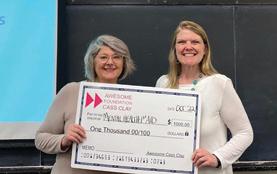




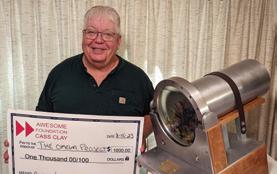










onthly, the CassClay Chapter of the Awesome Foundation gives a $1,000 grant to those "who can demonstrate and deliver great projects to make our area even more awesome to live in."

To highlight those making our community better further, the Awesome Foundation of Cass-Clay began highlighting their monthly winners in this publication back in July of 2021. And, while Fargo INC! won't be featuring the grantees anymore, we wanted to take a moment


to celebrate all of the Awesome Foundation Grant Award Winners that we have featured over the years while sending a thank you to Brandi Malarkey for contributing.
BY BRADY DRAKE

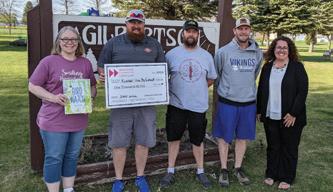
The Kindred Park Board and Kindred Public Library partnered to combine physical fitness and literacy through the StoryWalk® initiative, a unique project where community members can walk along park trails while engaging with children’s books displayed on mobile signs. The idea was inspired by the increased outdoor activity during the COVID pandemic, and both organizations contributed their expertise—with the Park Board constructing durable signage and the Library selecting interactive books.

The Moorhead Friends Writing Group, a community of 30-40 writers hosted by the Moorhead Public Library, was preparing to release The Great White North: A Winter Anthology. The group, which includes a diverse range of writers from various genres, focuses on helping each other improve their craft through feedback, goal-setting, and learning from guest writers.

Jessica Malvin and Jessica Verdi, coowners of The Freez in Moorhead, took over the beloved ice cream shop in 2018 to preserve its rich community history. Formerly known as Tastee Freez, the shop has been a local favorite since 1963, and the owners were determined to prevent its demolition.

Box of Balloons, Inc. works to bring birthday joy to children in need across Fargo through its volunteerrun initiative. Since its founding, the Fargo chapter has provided birthday parties for children facing hardships like poverty, medical crises, or homelessness. Co-founder Chelsey Strand and new director Chris Welsand work with local nonprofits and social workers to create personalized birthday boxes for each child, including cupcakes, gifts, decorations, tableware, and activities.

Moorhead Business Association (MBA) hosts an event called the Bridge Bash, an event designed to welcome college students to the area and introduce them to the local community. This year’s event, held in September, saw several changes, including a new Saturday date and a venue shift to Viking Ship Park, coordinating with Fargo’s Red River Market Student Day. The event, aimed at connecting students with local businesses, nonprofits, and recreational opportunities, featured a variety show instead of the traditional band performance, with local artists and entertainers showcased throughout the day. Supported by a $1,000 grant from the Cass Clay chapter of the Awesome Foundation, the event included unique performances such as hula hooping, pole dancing, and concrete carving.

The Robinson family, after moving to Fargo in 2018 and receiving community support during a time of financial hardship, founded the Life Care Unites Foundation in January
2021 to give back and help others in need. This nonprofit organization, created with seed money from the four Robinson children, offers programs like the Relief Shopping and Hot Meal services to provide healthy meals and essential items to underserved community members.

Minnesota State Community and Technical College (MState) is addressing menstrual equity by providing free menstrual products in women's and gender-neutral restrooms across its four campuses.

The Moorhead Police Department's Shop-with-a-Cop event, hosted by the Moorhead Police Athletics and Activities League (PAL), brings holiday cheer to at-risk and underserved children in the community. The program pairs children with police officers, giving them funds to buy
gifts for their families while fostering positive connections between the officers and the community. After shopping, the children’s gifts are wrapped by volunteers, and the officers secretly purchase a gift for the child as well.

For many first-generation immigrants and refugees, the challenge of not knowing English can be a significant barrier to finding employment and integrating into their new community. When Cani Adan relocated from Somalia to Fargo in 2015 and began working as an Employment Specialist with the Afro-American Development Association (AADA), he saw firsthand how limited English skills prevented many immigrants from securing jobs. In response, AADA launched an English Language Learning Program with the help of volunteers from local schools and the community.

"Faith4Hope is in the business of changing and shaping lives. The work we do at our non-profit organization is aimed at providing a holistic approach to solving some of our
society’s biggest challenges. Through our programs; Back2School Backpack Giveaway, Thanksgiving Basket, Christmas in the Dakotas, Food Pantry, Joyfest, Juneteenth, and AfterSchool Matters Community Center, we are committed to helping the BIPOC community and low-income families achieve equality and lasting independence."
-The Faith 4 Hope Website

Kory Powell-Oliver, a Graphic Communications student at Minnesota State University Moorhead (MSUM), discovered a passion for teaching after leading a web and graphic design class for the College for Kids & Teens summer camp program in 2021. Inspired by the positive response from his students, Kory decided to develop a Digital Design Boot Camp to help high school students explore technology and design.

Hyokyung Kwak, originally from Seoul, South Korea, found the perfect environment to pursue her passion for international childcare


when she joined Jasmin Child Care and Preschool in Fargo, ND. Focused on helping New American children integrate into American society, Jasmin Child Care offers a multicultural learning environment, where over 10 different cultures and nine languages are represented. Hyokyung, who plans to work in international education development, was drawn to the center’s unique approach to cultural diversity. Despite the positive impact the center has on the community, it faces financial challenges, particularly in maintaining and improving its facilities. With worn playground equipment in need of replacement, Hyokyung applied for and secured a $1.000 grant from the Cass Clay chapter of the Awesome Foundation to fund a new slide. This is just the first step in refurbishing the playground, with plans for additional equipment and sensory play areas.

Recovery Engaged Communities (REC) celebrated the grand opening of its physical space in May 2022, with an event featuring food, live music, and community activities. Initially conceived by a group aiming to bridge the gap between clinical and nonclinical recovery services, REC now offers peer recovery support, where specialists mentor and empower individuals in their recovery process. Accredited by the Association of Recovery Community Organizations, REC is the second recovery community organization (RCO) in western Minnesota. The $1,000 grant REC
received from the Cass Clay chapter of the Awesome Foundation funded their grand opening.

The team at Preference Employment Solutions has transformed their initiative to wear jeans for charity into a larger effort to directly assist job seekers through their “Casual for a Cause” program. After noticing that many qualified candidates lacked the basic resources needed to start work, the staff began using program funds to provide essentials like gas money, grocery gift cards, and safety gear. When a large room in their building became vacant, they decided to create the "Casual for a Cause Closet" to offer more comprehensive support.

Photographer Brittany Johnson’s passion project, Resplendent Residents, aims to showcase the beauty of elderly and disabled individuals, helping them feel seen and valued. Inspired by her experiences visiting her grandmother at The Leach Home in Wahpeton, ND, Brittany noticed the disconnect
between how older people are portrayed in the media and the vibrant individuals she met at the assisted living facility. She organized a photoshoot for the residents, allowing them to express themselves while providing them with dignity and joy.

Ricot Aladin transformed casual lunches into powerful learning opportunities with his project, Professional Lunch. Initially, Ricot began inviting professionals he knew out to lunch to learn about their careers and improve his communication skills. As he shared what he learned on social media, friends encouraged him to continue posting, leading to regular video uploads on Facebook and LinkedIn. In each video, Ricot’s guests discuss their profession, the challenges they face, and how they navigate them, offering insights for a broader audience. Over time, Ricot has expanded his guest list to include professionals from the community, all with a minimum of five years’ experience.

The Fargo Moorhead Humans of Color
Facebook group, created by Lynnea Eckhoff to help BIPOC individuals connect in the area, hosted its first Spring Fling event in May 2022 at the Hjemkomst Center. The group was formed to address the barriers people of color face when trying to find community in Fargo-Moorhead, especially for those not part of formal organizations or traditional networking structures.

Red River Rainbow Seniors is preserving the hidden history of LGBTQ individuals in the Northern Plains through its oral history project, Breaking Barriers: Harvesting LGBTQ Stories from the Northern Plains. Founded in 2016 with support from North Dakota AARP, the group provides support for older LGBTQ individuals and records the life stories of people from the 1930s to the present. The project began after Larry Peterson, a retired NDSU advisor, realized the importance of capturing the experiences of LGBTQ individuals in a region where their lives were often hidden. With training from NDSU's Public History department, volunteers have conducted over 150 interviews, documenting the challenges and triumphs of growing up LGBTQ in a predominantly conservative environment.

For the past four years, Em Christie has been spreading joy through art with a unique medium—painted rocks. Inspired by the FargoMoorhead Rocks group, a local offshoot of The Kindness Rocks Project, Em embraced the approachable art form of painting and hiding rocks with cheerful designs and messages throughout the community.

Joni Hjalmquist, a pediatric Occupational Therapist, is combining her expertise in child development with her passion for the outdoors through the Let's Grow OuTside Nature Camp. Launched in the summer of 2021 through the House of Everyday Learning (HOEL), the camp offers kids, from preschool through middle school, a chance to experience nature while building essential skills. Inspired by the benefits of outdoor therapy, Joni uses the camp to help children take healthy risks, socialize, and overcome challenges—whether it’s trying new activities, climbing trees, or simply being okay with getting dirty.

The Three Rivers Crisis Center in Wahpeton, ND, successfully hosted its second annual Pencils Plus: RichlandWilkin School Supply Drive, providing 600 backpacks filled with school supplies to local students.

Martha Wheeler, Lead of the allvolunteer Fargo Moorhead Local Group of Be SMART, made it her mission to keep kids safe from firearms by distributing gun locks and educational materials through events around the metro area.

Amna Millewa’s frustration with store-bought skin care products that worsened her acne, dark spots, and dry skin led her to experiment at home with natural ingredients.
After extensive research and trial and error, Amna developed her own skincare line, using shea butter, oils, and vitamins to treat her skin without harsh chemicals.

Brenda Koneczny, a licensed professional counselor and psychology professor at MSUM, was awarded a Awesome Foundation grant for working to make mental health support more accessible through Mental Health First Aid (MHFA) training. This evidence-based program aims to equip individuals with the tools to start conversations and offer support to those struggling with mental or emotional challenges, just as they would with physical injuries.

When the First Congregational United Church of Christ in Moorhead planted a garden, they didn’t expect it to grow into a Free Little Pantry for the neighborhood. Initially intended to share excess produce, they soon realized the deeper hunger in the community and began adding canned goods and non-perishable items.

In 2022, for the first time since 2018, Lakes and Prairies Community Action Partnership (CAPLP) hosted the Group Workcamp Home Repair project in Moorhead, inviting around 100 young people from across the country to help repair 20-25 homes. CAPLP has run this program every other year since 2003, partnering with West Central Minnesota Communities Action to alternate locations. The program focuses on helping older adults, veterans, and persons with disabilities stay in their homes by offering repairs like painting, wheelchair ramps, and weatherization, all completed by supervised youth crews.

Inspired by the success of One Book, One Community, which fosters shared conversations around a single book, the project was created by Cindy Mason of the Fargo Public Library and her youth services colleagues.

When a teen described the book selection at the West Central Regional Juvenile Center (WCRJC) as "Chicken Soup books and about a million bibles," former Clay County Commissioner Jenna Kahly knew it was time to help update the collection. Located in Moorhead, WCRJC provides short-term emergency placement for juveniles with behavioral, protection, dependency, and delinquency issues, but has been increasingly housing youth for longer periods due to a shortage of foster care options.

The Moorhead Legacy Education Foundation (MLEF) worked to improve school attendance by addressing the basic needs of students through a mobile app. With nearly 30% of Moorhead students missing 10% or more school days due to challenges like food insecurity, lack of winter gear, or access to hygiene products, MLEF planned to launch an app that allows students or families to request these items directly.

Minnesota-based visual artist Franklin Ugochukwu aimed to bring Moorhead’s inner beauty to its outer walls by creating murals that reflect the community. After leading a successful mural project at Churches United homeless shelter, where residents and children contributed to the vibrant artwork, Franklin was inspired to do more public art in Moorhead and Fargo.

Longtime friends Abdikarim Ibrahim and Abdi Isaack founded Ocean Stars FC, a new nonprofit in Fargo, after realizing they both had the same idea to help local kids through soccer. Ocean Stars FC provides mentorship and community-building opportunities for kids in the FargoMoorhead-West Fargo area, pairing every four to five kids with a mentor and providing resources to participate in soccer, such as equipment and transportation.

The Moorhead Police Athletics and Activity League (PALS) partnered with EHP Performance to launch a summer program that promotes healthy lifestyles and builds connections between officers and teens through workouts and mentoring. Selected by school resource officers and teachers, 14 teens meet twice a week with volunteer officers for exercise, lessons on positive attitudes, and time to connect.

At the Indigenous Association’s regalia class in Fargo-Moorhead, sewing machines hum as participants learn not only how to create traditional garments for powwow dances but also connect with their indigenous culture.

The MSUM Oceanarium in Moorhead is a hidden gem offering an interactive marine experience far from the nearest ocean. Home to over 150 organisms, including fan favorites like horseshoe crabs and a new jellyfish exhibit, the Oceanarium offers unique opportunities for hands-on learning, especially through its Junior Aquarist Camp for Kids.

Amanda and Jared Hoeft, a married musical duo, showcased their wideranging skills in a unique benefit concert, "Medieval Myths and Magic," in November 2023 in support of the Fargo-Moorhead Gay Men's Chorus. The performance featured a mix of medieval music, modern compositions, and original works, including a piece inspired by the call of the loon, influenced by the Hoefts' vacations near Brainerd, Minnesota.

Rodney Haug, a nationally known kaleidoscope artist from Hawley, MN embarked on his most ambitious project yet, "The Omega Project," a large kaleidoscope with a 15-inch object chamber that he hopes will be the culmination of his 30-year career.

Farm in the Dell of the Red River Valley continues to grow with the help of a $1,000 grant from the Cass Clay chapter of the Awesome Foundation, which helped fund greenhouse renovations to extend their growing season. This nonprofit provides employment opportunities for individuals with developmental disabilities through communitysupported agriculture. With the greenhouse updates, Farm in the Dell will now be able to start their own seedlings in the spring, extending the employment season for their garden engineers by one to two months.

In 2019, the Moorhead City Council replaced Columbus Day with Indigenous Peoples' Day, and in 2023, Minnesota followed suit, marking a historic shift in recognizing Indigenous history. Seventeen-year-old Moorhead High student DJ Smith, who advocated for the change at age 12, is continuing his work by addressing the lack of accurate Indigenous education in schools.

In his final year of a physics and computer science degree, Benjamin Ockert is planning a unique monthlong photographic bicycle tour beginning in Fargo and covering over 600 miles of trails through Minnesota. Equipped with a restored 1970s Bronica EC camera, Ben aims to capture the beauty and stories of local communities along the way, while visiting cities like Duluth, St. Paul, and Bemidji. Combining his newfound love for photography and cycling, the trip is both a graduation gift to himself and a celebration of local landscapes, designed to challenge the notion that “there’s not much to do around here.”

C.A.S.A. (Cultura, Amigos, Salud, and Ambiente), a Minnesota nonprofit, is dedicated to helping the Latino community in the Fargo-Moorhead area feel more at home by providing practical support and fostering connections.

In a time when polarization and misinformation dominate, local, state, and national elections can seem daunting, but for many in the community, they represent an exciting opportunity. For New Americans, gaining citizenship and participating in democracy is a significant achievement. However, language barriers can make voting difficult, prompting the League of Women Voters of the Red River Valley to team up with the Immigrant Development Center on a pilot project. This initiative, supported by a January 2024 grant from the Cass Clay chapter of the Awesome Foundation, aims to translate VOTE411.org candidate responses into additional languages for the November 2024 election, starting with state legislative races in Cass County.

The 5th Annual Fargo Juneteenth Celebration, organized by Fred’s Dissonance, took place on June 15th at NDSU's Renaissance Hall. Founded by Frederick Edwards Jr., the event celebrates African American heritage and promotes cultural exchange and understanding. Juneteenth, now a federal holiday, commemorates the legacy of enslaved Americans and welcomes everyone in the community to participate. The celebration featured art, performances, food vendors, and activities for all ages in a safe, inclusive, and alcohol-free environment.

In January 2021, the Robinson family—Katrina, Jeremy, and their four children—founded the Life Care Unites Foundation to give back to the community, offering a Relief Shopping and Hot Meal program to provide essential items to those in need. Initially partnering with The Arbors at McCormick Park, they've now expanded their outreach with new locations at Roots Hair & Soul and the Church of God's Word, allowing them
to serve more people in the FargoMoorhead area. The Relief Shops offer free clothing, hygiene kits, and hot meals to community members, and the new partnerships will enable the foundation to hold separate, smaller events in various locations.

The TELL, an unscripted storytelling event that originated in 2012, returned after a four-year hiatus due to the pandemic. Organized by a group of dedicated volunteers, the reboot takes place on the Thursday of each month. Each event invites attendees to share personal, true stories based on a monthly theme, like “Starting Over” and “Revolution,” with a panel of judges selecting a winner.

The Canopy Peer Navigation program, run by Canopy Medical Clinic in Fargo, is North Dakota’s first peer support initiative for people living with HIV. Launched in 2022 in partnership with the North Dakota Department of Health, the program offers personalized mental health services and group support meetings to over 500 individuals
living with HIV in the state. Peer Navigators, who have personal experience with HIV, provide guidance on navigating medical systems and emotional support. Canopy’s in-person and online support groups allow members to share experiences, reduce isolation, and combat the stigma often associated with the illness. The program also addresses misconceptions about HIV, emphasizing that modern treatment makes the disease manageable and untransmissible. Canopy's support groups meet monthly at private locations, with funding from the Cass Clay chapter of the Awesome Foundation helping to cover costs for meals, meeting spaces, and guest speakers.

The Native American Christian Ministry of Fargo Moorhead is hosting an educational and spiritual event for Indigenous women this September at the Neighborhood Church in Fargo. Led by Ojibwe leader JT Shining Onesided, the event will include traditional Ojibwe ceremonies celebrating womanhood, such as the Moon Ceremony and Berry Picking Ceremony, along with a hands-on ribbon skirt-making workshop. Participants will learn about the cultural significance of the ribbon skirt and engage in spiritual practices like smudging, singing, and prayer. The event is open to anyone interested in deepening their spiritual connections, with materials provided for making the sacred skirts.




CO-FOUNDER, ASSESSMENT AND THERAPY ASSOCIATES OF GRAND FORKS
Dr. Catherine Yeager is a co-founder of Assessment and Therapy Associates of Grand Forks (ATAGF), a mental health clinic that provides psychotherapy, evaluations and assessments, sports psychology, and consultation services for all ages.
Dr. Yeager and her business partner Dave Jackson opened ATAGF in 2006 with the goal of providing highquality mental health care for their community. From humble beginnings with just two psychologists and one support staff member, ATAGF has grown into a team of over 20 providers with a variety of specialties.
In the past years, ATAGF has become one of the loudest voices in our local medical community concerning the overdiagnosis of mental health conditions in children. Dr. Yeager leads the charge, helping evaluate the impact overdiagnosis might have on the misdiagnosed children as well as on those who do have mental health conditions. Dr. Yeager is helping educate parents, medical students, and the community by speaking at different events and engaging with youth-centered organizations.
Dr. Yeager specializes in child and adolescent assessment and family therapy. For the last 10 years, her focus has shifted from practicing as a child psychologist to being an advocate for proper diagnosis of developmental disorders such as autism and ADHD.
“I wanted to be a psychologist ever since I knew what psychology was,” said Yeager. “I’ve always been interested in the development of kids and wanted to make a difference in children’s lives. I believe that advocating for meaningful diagnosis will help make a difference for children and parents.”
Even before COVID-19, the number of children being diagnosed with mental health conditions was so high that it was projected that if this continued, more than 80% of people would have a mental health diagnosis by the
By Mason Gravseth
time they reached 21 years old.
Some of the increase is the result of societal issues, and there are many things in the world today that impact kids’ mental health.
“There are many reasons for the increase in mental health problems in today’s children, and most of these problems are not the result of neuropsychological developmental disorders. Kids today are spending much more time with phones and iPads, and these give very immediate reinforcement. This changes the way the brain works and can make the kind of learning kids do in the classroom much less appealing. Many of the attention and behavioral issues we see in young kids are related to a combination of how kids spend their free time and increased academic demands at younger ages.”
The same can be true for older kids and even adults.
“Everyone struggles with attention when they are facing constant distractions, but that is not a neuropsychological or developmental problem—it's just being human. We are just not meant to multitask the way so many of our lifestyles demand.”
Additionally, she attributes some cases of misdiagnosis to symptoms that are the result of other problems, such as trauma histories, anxiety, or behavioral disorders.
Misdiagnosing a developmental disorder in children whose problems have another cause is an issue for many reasons. First, the wrong diagnosis can lead to the wrong treatment.
“If a child who is acting out due to a traumatic history is misdiagnosed with autism or ADHD, it is much less likely that that child will get the appropriate type of help for the actual problem,” she said. “Misdiagnosis of developmental disorders can also change the public’s perception of what these disorders look like, and
this can lead to more requests for evaluations and potentially more misdiagnoses of mild mental health problems or even normal childhood behavior. It creates a vicious cycle.”
Yeager also worries about how more diagnoses may impact the resources that are available for those with the most severe developmental problems.
“In a perfect world, we would have plenty of services and providers and anyone with any degree of mental health or developmental problem would get what they need. Unfortunately, mental health providers are already spread pretty thin.”
One of the ways Dr. Yeager helps advocate for her young patients is to normalize struggling.
“Recognize that struggling is a normal part of life and understand that processing stress in a productive way can help kids learn to deal with adversity later in life,” she said. “Most parents want to limit the amount of distress their kids experience and that is very understandable, but parents should feel confident that just because a child is struggling doesn’t mean that anything is 'wrong' with that child. Most of the time symptoms aren’t disorders. It’s ok to be different and it’s ok to struggle sometimes. These things don’t necessarily mean that you have a psychological disorder.”
It’s a message she also shares with other health care providers at speaking events like the North Dakota Psychological Association conference held earlier this year.
For those interested in further information on this topic, Dr. Yeager recommended a book titled “Saving Normal: An Insider's Revolt Against Out-of-Control Psychiatric Diagnoses DSM-5, Big Pharma, and the Medicalization of Ordinary Life” by Allen Frances. You can also reach out to her through ATAGF at grandforkstherapy.com


ohn Machacek, Chief Innovation Officer for the Greater Fargo Moorhead Economic Development Corporation, has worked with countless startups throughout our community over the years. He knows their ups, and their downs, but most of all, he knows the questions to ask them. Here are John Machacek’s 10 questions for Troy and Emmy Vareberg, co-founders of Blue Comply
By John Machacek

by Josiah Kopp

01
First of all, congratulations on the recent win in the regional Pegasus Tech Ventures Startup World Cup pitch competition. I hope the Grand Finale pitch event in San Francisco goes well and is fruitful. To start with this interview, will you please tell me your Blue Comply elevator pitch?
Blue Comply is committed to offering advanced technology solutions that help industries detect and mitigate methane emissions. Our patented device integrates multiple sensors with intelligent data reporting to provide real-time insights on equipment health, particularly thief hatches—one of the key sources of methane leaks. By enabling faster detection, we help reduce environmental impact and minimize operational risks.
02
To what extent are methane leaks an issue at oil wells?
Fugitive methane emissions are a critical issue in the oil and gas industry, leading to both financial losses and environmental challenges. Oil producers lose 1.5% of the methane they produce on average from fugitive emissions,
costing them billions of dollars each year in lost products. The high potency of methane as a greenhouse gas and its significant effect on the environment have led to new government regulatory fines, placing greater pressure on producers to mitigate emissions. Thief hatches, located on top of storage tanks, are one of the primary sources of methane leaks on oil sites.
We provide precise, real-time detection of fugitive methane from thief hatches, enabling oil and gas producers to respond quickly with corrective measures and achieve their emission-reduction goals. By reducing emissions, our technology helps them minimize loss of sellable products, remain compliant with industry regulations, avoid costly fines, and reduce the US’s environmental impact.
03
For someone that doesn’t know much about the oil and gas industry, what do you mean by a thief hatch?
A thief hatch is an access door on the top of an oil storage tank which allows for typical oil site procedures, such as inspection and sampling. Through normal operations, these hatches can be inadvertently left open, or unlatched, which results in unintentional emissions. Internal components of thief hatches also experience wear-and-tear, leading to additional sources of leaks. Our
third-party-tested, patented device attaches to the top of the thief hatch and monitors methane levels and hatch position to identify potential leaks. We send this data wirelessly, either to a cloud-based dashboard via cellular communications, or directly to a producer’s system via LoRa, to intelligently provide insights and alerts, enabling producers to quickly and confidently address emissions from thief hatches.
Through our work in the oil and gas industry over the past 15 years via our consulting engineering firm, Vareberg Engineering, we learned about the manual process that producers were currently using to find, document, and repair methane leaks on all their well sites. It was evident there was a need for a more efficient, less costly solution. Our experience in engineering services at Vareberg Engineering meant that we were well-versed in addressing problems using existing technology, but this was different. We couldn’t find anything on the market that sufficiently addressed the issue, so we decided to develop our own, novel solution.
05
After being a service company for so many years, I imagine both the learning curve and the resources needed are quite a leap from that. How has this new direction gone so far?
It's been such an amazing experience to learn the ins and outs of a completely different business model. We have been fully immersed in R&D for the past couple of years and just completed a three-month blind study to determine the effectiveness of our initial design. These are things we definitely didn’t experience with our consulting business, but we’ve embraced each challenge as a new opportunity for Blue Comply.
06
These differences would also require the need for different types of talent needs. How have you gone about finding people that may have the particular product and tech skills?
To this point, we have been fortunate enough to add individuals to our team that we’ve worked with in the past. It’s been great
building a group of excited, talented individuals who have filled Blue Comply’s needs perfectly and who care about our mission.
07
So similar with finding the right talent, how about any needs to find partners to source and manufacture components for the product?
We both grew up in North Dakota, graduated from NDSU and returned to the area over 27 years ago. Because of the time spent here, we have a large network of connections and relationships to draw upon. Whether it is the initial design, supply chain, manufacturing, or customer acquisition, we have been able to approach our peers for invaluable assistance and partnerships. We also have to admit there have been a few instances of “in-the-right-place-at-the-righttime." Overall, the support from our network is a testament to the closeknit community that Fargo and the State of North Dakota provide.
08
Definitely a theme here about the importance of your networks and relationships in helping push your business forward. With North Dakota’s robust oil industry, as well as its economic development and innovation resources, how has that aided the development and growth of the company?
We have been extremely fortunate to be able to work with the State of North Dakota through both the Department of Commerce and the Industrial Commission. Specifically, our work with the Industrial Commission led us to the Oil & Gas Research Program, whose matching grant program helped us get our initial device developed and patented. With that initial success, we were also able to secure a second grant, as well as a loan from the LIFT fund to further develop our product and company. There are other State programs out there such as the Seed Capital Investment Tax Credit that we may be able to leverage as we continue moving forward.
If you could go back in time to Emmy and Troy from several years ago, what hindsight advice would you give yourself?
Emmy: With Vareberg Engineering, we got to build a business together and maintain a work-life balance. This allowed us to be active in our kids’ lives while they were in school. Once we were empty nesters, it took a while to shift from the routine that we knew to really diving into this idea of solving a huge, important problem. If we could sit down with ourselves five years ago, we’d probably say something that sounds like a Nike ad: “Just do it and trust in yourselves.”
Troy: This has definitely been a unique experience for us, and it has come with hurdles we haven’t seen before, but we stay motivated by the idea that we can make a significant difference. Like Emmy said, telling our past selves to just jump in together and meet the challenges as they come would have eased some of the early hesitation.

Methane emissions, whether you view them from an environmental or a financial perspective, are a time-sensitive issue. We’ve been fortunate to receive funding from grant programs within the state to help build and prove our devices, but getting them on oil sites is critical. We are looking to expand our team, develop partnerships, and raise additional seed capital to bring the best product we can to producers. We welcome any level of conversation and support, but these are particular needs we would love help from the community in addressing.

